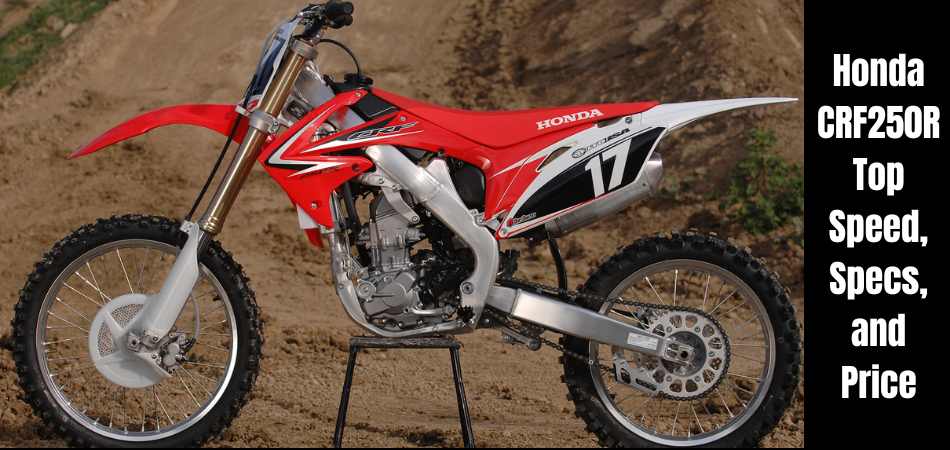
The Honda CRF250R is a dirt bike you’re probably familiar with if you’re a fan of dirt bikes. How is this particular model different from others? Or what about the CRF250R Top Speed?
The CRF250R has lots to offer when it comes to its top speed, specs, and features. A high-performance dirt bike that stands out from the rest thanks to its impressive specs and features.
One of the most powerful bikes on the market is the Honda Crf250r, and it’s an absolute game-changer. Compared to previous generations in the Honda motorbike collection, it features numerous improvements.
With all these features combined, the CRF250R is a must-have for any racer. This article will provide you with detailed specs and features of this classic bike, relevant reviews, and answers to the most common questions especially about CRF250R Top Speed.
Honda CRF250R Overview
In 2004, Honda introduced its CRF250R motocross bike. The motorcycle’s 249cc four-stroke engine produces 60 to 70 mph and is powered by a four-stroke engine.
With the Honda CRF250R this year, Honda aimed to improve the engine and make it lighter, stronger, and faster. As Honda looked to reduce weight and put more energy into its step-up, the body parts were bolted together with 8 bolts instead of 12 bolts previously. The 450 looks like it and has many of the same features as the 500, but some major improvements have been made.
A 2.1-gallon fuel tank and 233 pounds of dry weight make up the bike’s specifications. A digital instrument panel, an adjustable clutch lever, and an adjustable handlebar are included. Honda has a very fast development process for the CRF 250R.
In the 250 class, horsepower is everything. Every riding experience starts with horsepower. Anyone who has handled a bike at a race track knows that there’s much more to it. The location of your bike’s power generation is critical to how much power it can potentially produce.
Fortunately, that’s where the Honda CRFR250R race bike excels. Here are some specs and features to get you started.
How Much Does the Honda CRF250R Cost?
New CRF250Rs start at $8,299, but they add a $400 “Destination” fee and a $100 “Freight” charge. Additionally, taxes and any other fees make the OTD price considerably higher than the retail price.
Every brand is doing it now to offset higher production costs by getting the “sticker price” cheaper.
Model Year History & Changes of Honda CRF250R
In the past few years, there have been so many changes, but I do not want to list them all. From 2004 to the present, here are all the major updates to the Honda CRF250R:
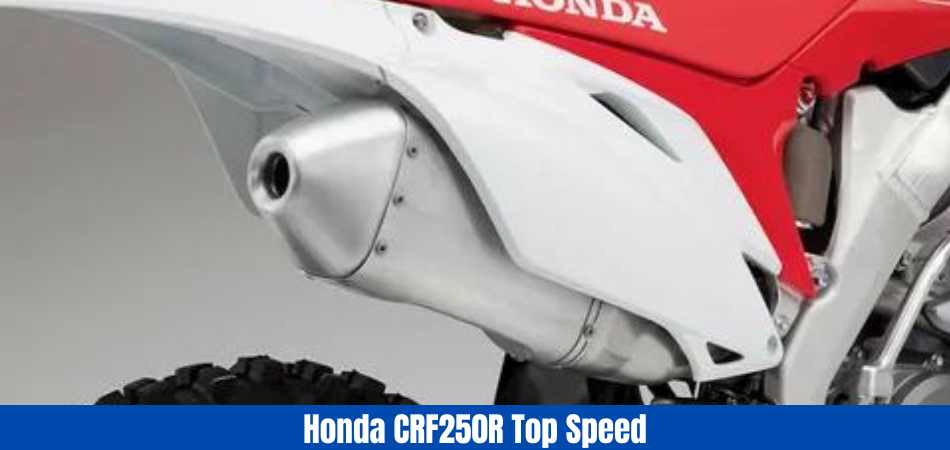
- 2004: Honda CRF250R debuts
- 2005: New cylinder head, cam, and mapping for better torque, and upgraded clutch & trans parts
- 2006: Dual exhaust and muffler installed
- 2007: Upgraded cylinder head, exhaust, and transmission to improve power and shifting
- 2010: First year for fuel injection, single exhaust muffler updated
- 2012: Revised cylinder head and throttle body for a broader power curve (more torque)
- 2015: Air forks added
- 2018: Electric start, new DOHC engine (vs older Unicam engine) – more horsepower, less low-end torque
- 2022: Improved torque in the low and midranges of the engine
CRF250R vs CRF250F
Although both dirt bikes are 250cc 4-strokes, they are very different in almost every aspect. In comparison to the 250F trail bike, the 250R has almost twice the power, stiffer suspension, and a higher seat height.
CRF250R vs CRF250RX
There is not much difference between the two bikes, except that the 250RX has a slightly softer suspension and power curve, which makes it the better off-road bike or racer.
CRF250R vs CRF250X
In contrast to the CRF250X, which has a softer suspension and a detuned engine for smoother and more predictable performance, the CRF250X is an older enduro bike. This engine is similar to the first 250R, except it has an electric start and is much quieter. The 250X was discontinued in 2018.
Honda CRF250R Specifications
- MSRP: $8,199
- Engine: DOHC, liquid-cooled single-cylinder; 4 valves/cyl.
- Displacement: 249cc
- Bore x Stroke: 79.0 x 50.9mm
- Compression Ratio: 13.9:1
- Transmission/Final Drive: 5-speed/chain
- Dirt Rider Measured Horsepower: 37.8 hp @ 11,300 rpm
- Dirt Rider Measured Torque: 18.0 lb.-ft. @ 9,400 rpm
- Fuel System: EFI w/ 44mm throttle body
- Clutch: Wet, multi-plate; cable actuation
- Frame: Aluminum twin-spar
- Front Suspension: Showa 49mm coil-spring fork, compression damping and rebound damping adjustable; 12.2 in. travel
- Rear Suspension: Showa shock, spring preload, high/low-speed compression damping, and rebound damping adjustable; 12.3 in. travel
- Front Brake: Nissin 2-piston caliper, 260mm disc
- Rear Brake: Nissin 1-piston caliper, 240mm disc
- Tires, Front/Rear: Pirelli Scorpion MX32 Mid Soft; 80/100-21 / 100/90-19
- Rake/Trail: 27.2°/4.5 in.
- Wheelbase: 58.1 in.
- Ground Clearance: 13.1 in.
- Dirt Rider Measured Seat Height: 37.6 in.
- Fuel Capacity: 1.7 gal.
- Dirt Rider Measured Wet Weight: 231 lb.
12 New Features of Honda CRF250R
1. Exhaust system with one muffler
The Honda CRF has a single-muffler exhaust system designed to maximize power and minimize weight. Exhaust gases flow unrestricted through this system, increasing power and performance.
For those who want to enjoy their ride without disturbing the peace, the muffler also reduces noise levels.
2. Controls for HRC launches
Honda CRF models feature HRC Launch Control as an exclusive feature. Based on the rider’s input, it automatically adjusts engine output and clutch engagement to get the best start possible.
Due to its ability to take into account both the weight of the rider and the terrain, this system provides many advantages over standard launch control systems.
3. Exhaust and intake layouts for downdrafts
Designed solely to win Dakar Rally, Honda’s CRF1000L is a machine that was built to win. As a result, it took home the top spot in 2013, 2014, and 2015. Is there anything special about this bike?
4. Wheels
Rear’s 2018 CRF450R gets new aluminum wheelsirePirelli Scorpion MX32 80/100–21 w/ tube
There are new aluminum wheels on Honda’s CRF450R for 2018. There is a 21-inch front wheel and a 19-inch rear wheel. The tires wrapped around both wheels are Dunlop MX3S.
It will be interesting to see how the change in wheel size affects the handling of the bike.
5. Clutch assembly with nine discs
Honda is the only manufacturer to offer a nine-disc clutch assembly. A clutch with multiple friction discs provides smoother, more linear power delivery and better durability than a clutch with only six discs.
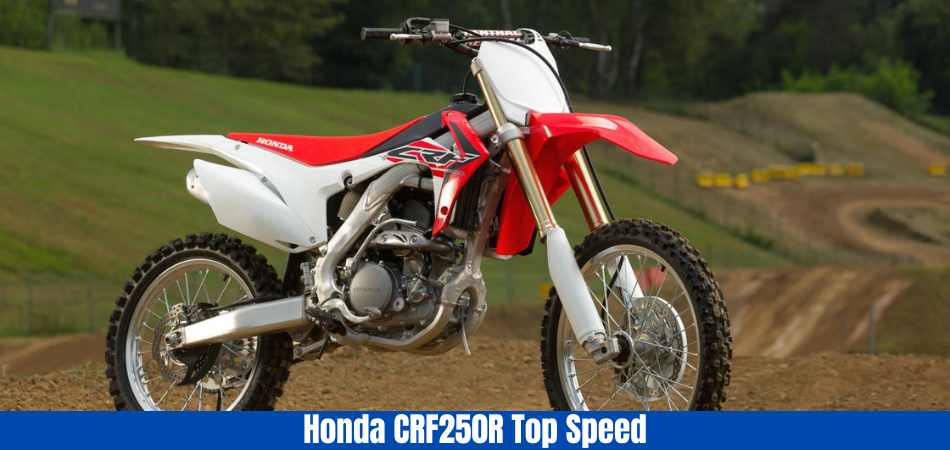
In addition, the discs are staggered to reduce the amount of gear rattle during engine braking.
6. Enhanced frame rigidity
Honda developed the CRF250R with the help of its factory race teams. Compared to the previous model, the CRF250R features a stiffer and lighter frame.
In addition to the longer swingarm, the new frame provides better stability at high speeds.
7. The fuel injection system
In the Honda CRF, the fuel injection system is electronically controlled. Based on the engine load, it adjusts the amount of fuel delivered to the engine using sensors.
As a result, the engine produces more power, consumes less fuel, and emits fewer emissions.
8. Button for selecting engine mode
On the Honda CRF, the engine mode select button allows you to choose between Eco, Normal, and Power modes.
9. Engine and gearbox lubrication shared
The Honda CRF has a shared lubrication system for the engine and gearbox. In this way, both the engine oil and gearbox oil are lubricated by the same oil, making it easier to maintain both components.
This has the disadvantage of requiring both components to be replaced if one fails.
10. Starter with an electric motor
If you’re referring to the Honda CRF450R, it’s a dirt bike with an electric start. There is a four-stroke engine and a five-speed manual transmission.
11. ShowaⓇ Spring Fork
A great addition to the Honda CRF is the Showa spring fork. By increasing stiffness and damping, it provides a smoother ride and better handling.
Additionally, your forks are equipped with a hydraulic stop valve that prevents oil from leaking out of the compression chamber.
12. Short Swingarm
One of the key performance features of the CRF is its short swingarm. At high speeds, it provides more stability and allows the bike to change direction more quickly.
In addition to providing a more comfortable ride, the swingarm absorbs bumps and vibrations better than a longer one.
What is the Honda CRF250R Top Speed?
There is no doubt that the Honda CRF250R is a beast on wheels and an absolute winner for racers who are ready to go the distance. So, What is the Honda CRF250R Top Speed? In stock gearing, this bike has a top speed of 67 mph and a maximum power output of 39HP. You can easily get 100mph out of it by adjusting the gearing.
On the race track, it offers smooth power delivery, a sweet spot for a wide range of rider experiences. Fuel-injected engines are more reliable, consume less fuel, and produce more power and torque.
According to some owners, the CRF250R is the best cornering motorcycle among all 250s and 450s they have ridden!
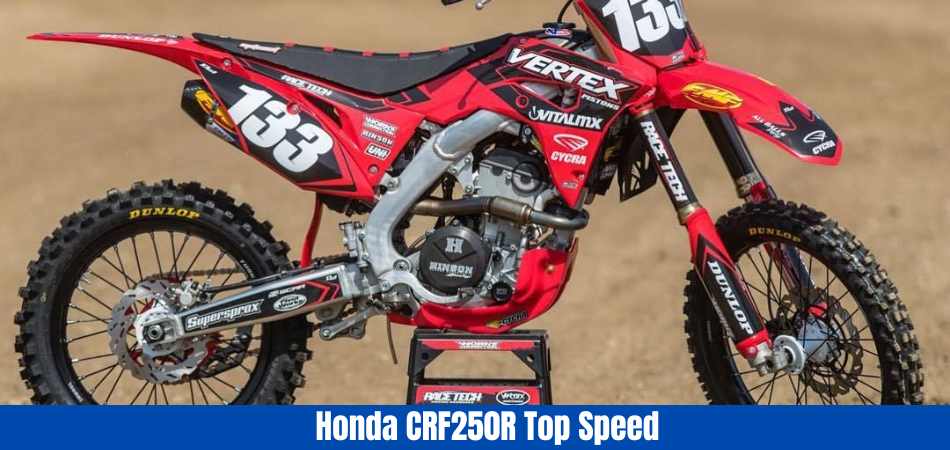
Whenever you come into corners or sharp bends, the bike just lays over for you. You just let your momentum take you through, and the bike does exactly what you want it to do.
Getting out of turns and corners quickly, accelerating, everything about riding a sportbike is a thrill, it’s visceral, it’s visceral. Because the CRF250R is lightweight, the rider’s weight won’t slow it down when it gets to maximum speed.
In spite of everything that’s been said about the CRF250R, there’s still room for improvement, right? Here are some tips on how to make your CRF250R better and more fun!
How To Improve The Honda CRF250R Top Speed? 7 Easy Steps!
1. Clean and adjust the air filter: Your engine will perform better if the air filter is clean and free of debris. To ensure optimal performance, adjust the air mixture screw if necessary.
2. Upgrade the exhaust system: Installing a new exhaust system can improve engine efficiency and increase horsepower.
3. Increase the compression ratio: You can boost the speed and power of your Honda CRF250R by increasing its compression ratio.
4. Install an aftermarket camshaft: By installing an aftermarket camshaft with increased lift and duration, you can get more power at higher RPM levels, which results in greater speed.
5. Adjust valve clearances: Making sure valve clearances are adjusted properly is important for maximizing engine performance and ensuring the efficient operation of your Honda CRF250R.
6. Change spark plugs: Hotter spark plugs will help your engine to fire more efficiently, which will increase speed and power.
7. Upgrade the carburetor: You can improve speed and acceleration by installing a larger or high-performance carburetor.
What are the Pros and Cons of the Honda CRF250R
There is plenty of power and agility in the Honda CRF250R dirt bike. But What are the Pros and Cons of the Honda CRF250R?
Before purchasing one, there are a few things you should know. A list of the Honda CRF250R’s pros and cons follows:
Pros of Honda CRF250R
- Plenty of power — With the CRF250R, you can overcome any obstacle with ease.
- Nimble handling — Whether you’re a beginner or an experienced rider, the CRF250R is very easy to handle.
- Solid build quality — Due to its durable construction, the CRF250R can withstand a lot of abuse on the trails.
Cons of Honda CRF250R
- Price — A dirt bike like the CRF250R is expensive.
- Limited availability — The CRF250R is only available at a small number of Honda dealerships, so you may have a hard time finding one.
- Maintenance — Keeping the CRF250R in good working order requires regular maintenance.
How Reliable is the Honda CRF250R?
There is a common misconception that 250F motocross bikes are unreliable, but that’s not always the case. Most Honda CRF250Rs are just as reliable, if not more than any other MX bike brand.
You can expect it to last quite a while as long as you take care of it and don’t constantly hit the rev limiter. How long will it take?
An expert racer might need to rebuild the top end every 20 hours, but a novice racer might get 100 hours or more with proper maintenance.
Are there Any common Issues in the Honda CRF250R?
There were a lot of complaints about the valvetrain during the first couple of years of the CRF250R. Your valves are much more likely to burn up if you don’t change the oil or keep the air filter clean.
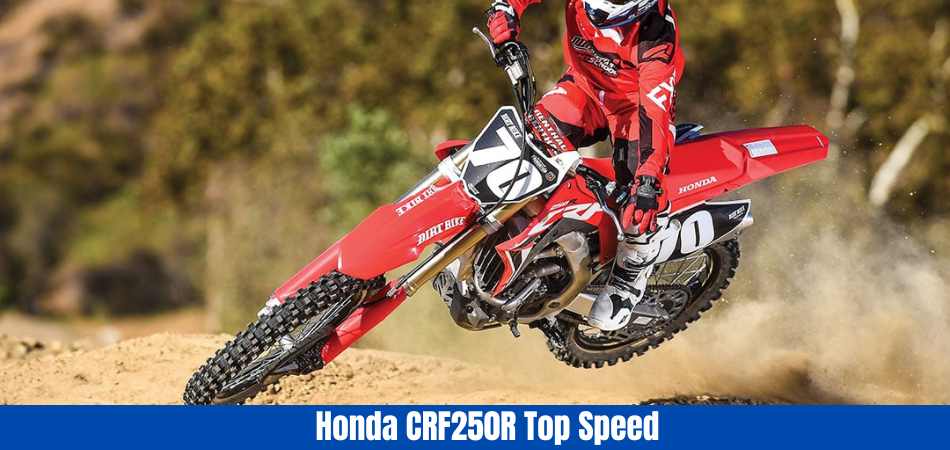
A 2006 Honda upgrade improved the quality of the metal, which appeared to eliminate any common problems.
Other than that, if you take care of it properly, there shouldn’t be any major problems. It may leave you stranded with a blown engine if you fail to check the oil every time you ride your motorcycle.
Can the Honda CRF250R be Trail Ridden?
The short answer is yes. You can, but it’s one of the worst choices you can make, especially if you’re a new rider or returning after a long break. Because of its snappy power and stiff suspension, it is harder to ride and more exhausting.
It’s possible to modify it to make it more “woods-friendly”, but you’d be better off learning how to ride a beginner-friendly trail bike and not relying on the extra power that an MX engine provides.
Conclusion: Honda CRF250R Top Speed
The CRF250R allows you to F.E.A.R. – Forget Everything And Ride! With this two-wheel beast, you feel unstoppable. For riders who are ready to go, it’s a no-brainer because of its lightweight, powerful engine and classic mechanics.
With this bike, we’ve covered quite a bit, and that’s just scratching the surface because words alone can’t describe the experience. It’s nothing short of a masterpiece. Only a champion’s bike should be used!
It’s time to ride; it’s time to win. This bike is the best and will not disappoint you in a race if you consider getting one for yourself. In fact, Honda claims that the new CRF250R is the strongest CRF250R in history.
Read more of our articles here.
Read Also: Best Motocross Bike 6th Place—2023 Honda CRF250R
FAQs
How fast can a Honda CRF 250 go?
CRF250R dirt bikes are designed for experienced riders. In approximately six seconds, it can go from 0-60 mph and reach a top speed of 80 mph.
Is 250cc faster than 150cc?
The 250cc is the right choice for you if speed thrills you and you have the personality of a sportsperson. The bikes are quite fast compared to 150cc bikes and are suitable for beginners.
Is a CRF250R a 2 stroke?
Designed and manufactured by Honda, the Honda CRF series is a line of four-stroke motorcycles for motocross, trail riding, and dual sport riding.
How heavy is a CRF 250R?
In the class of 2023 250 four-strokes, the 2023 Honda CRF250 is the second lightest at 219 pounds, behind the 2023 GasGas MC250F.
Can you lower a CRF 250R?
With this fully adjustable lowering link, you can lower the rear of the motorcycle to any height between the factory and lowered 4 inches (100 mm).
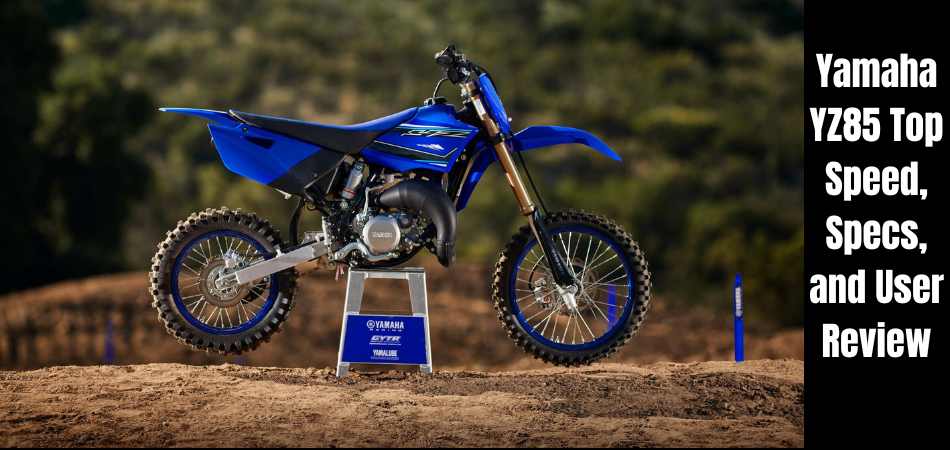
Do you want to buy a Yamaha YZ85, but aren’t sure about the YZ85 Top Speed? It doesn’t matter if you’re looking for your first dirt bike, want to race motocross, or somewhere in between, you’ve come to the right place!
For the year 2024, Yamaha has updated the YZ85 mini motocross motorcycle. Motorcross motorcycles are available in two variants with a starting price of $4,799. The engine is a two-stroke, 85cc liquid-cooled, reed-valve induction engine. There is a 6-speed transmission on the Yamaha YZ85, as well as a fully adjustable suspension at the front and the rear.
Here is a review of the YZ 85 Top Speed that will help you decide whether it’s right for you, what to expect when looking for one, and what to expect when owning one.
Overview of Yamaha YZ85
Yamaha’s new YZ85 features updated and sharp-looking graphics, but only one color option is available. To optimize strength and rigidity, Yamaha enhanced the chassis in this year’s models.
Lightweight aluminum swingarms provide improved handling stability and reduce weight. An adjustable KYB link-type rear suspension and 36mm KYB inverted front forks are featured on this motocrosser.
There is a single hydraulic 220 mm front disc brake and a single hydraulic 190 mm rear disc brake on the Yamaha YZ85. With 17-inch front and 14-inch rear tires, it comes with 17-inch front and 14-inch rear wheels. There is a 12.6-inch ground clearance on this car, and it weighs 161 pounds.
| Engine | 85cc liquid-cooled 2 stroke |
| Transmission | 6-speed manual clutch |
| Seat Height | 33.1” (84.1cm) / 34.8 (88.4cm) |
| Wheelbase | 49.4″ / 50.6″ |
| Suspension Travel (Front/Rear) | 10.8″/11.1″ |
| Weight | 161 lbs / 165 lbs |
| Horsepower | 20 HP |
| Top Speed | 65 MPH |
Yamaha YZ85 Specs
1. GENERAL INFORMATION
- Manufacturer – Yamaha
- Model – YZ85
2. Brakes
- Front – Hydraulic disc, 220 mm
- Rear – Hydraulic disc, 190 mm
3. Tires
- Front – 70 / 100-17 Dunlop® Geomax MX3SF
- Rear – 90 / 100-14 Dunlop® Geomax MX3S
4. DIMENSIONS
- Length – 71.7 in.
- Height – 44.7 in.
- Width – 29.9 in.
- Weight Wet – 161 lb.
- Ground Clearance Maximum – 12.6 in.
- Wheelbase – 49.4 in.
- Seat Height – 33.1 in.
5. DRIVETRAIN
- Transmission – 6-speed
- Final Drive – Chain
6. ENGINE
- Engine – 2-stroke; reed-valve inducted
- Cooling – Liquid
- Displacement – 85 cc
- Bore x Stroke – 47.5 x 47.8 mm
- Compression Ratio – 8.2 ~ 9.6:1
- Clutch – Multiplate wet
- Carburetion – Hitachi Astemo® Keihin PWK28
- Fuel Capacity – 1.3 gal.
7. OPERATIONAL
- Front Suspension – KYB® inverted fork; fully adjustable
- Travel – 10.8 in.
- Rear Suspension – KYB® single shock; fully adjustable
- Travel – 11.1 in.
- Rake – 26.3°
Trail – 3.5 in.
Best Features of Yamaha YZ85
Wondering about the features? Well here are the best features of Yamaha YZ85.
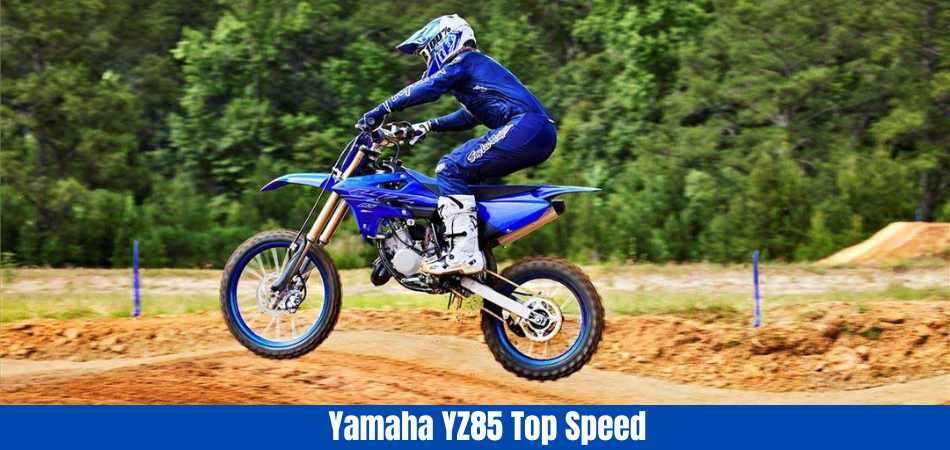
- A removable rear subframe is available
- Swingarm made of aluminium with high rigidity
- Inverted front forks with 33 mm KYB full adjustment
- Rear suspension with fully adjustable KYB linkage
- Hydraulic disc brakes with wave design at the front and rear
- Master cylinder redesign at the rear
- 17-inch spoke rims on the front and 14-inch spoke rims on the rear
- Dunlop MX3S tires with high performance
- Ergonomic adjustments for riders
- Engine with a single cylinder and two strokes
- System for Yamaha power valves
- Carbide flat-slide 28mm Hitachi Astemo Keihin
- Tuned expansion chamber
- Radiators with high capacity and lightweight
- Transmission with six speeds
What is the Yamaha YZ85 Top Speed?
The Yamaha YZ85 Top Speed is around 65 mph (105 km/h). For a small lightweight bike like this one, the YZ85 Top Speed might not sound like much compared to bigger bikes.
To reach maximum speed, the engine is designed to consume as little fuel as possible without putting too much strain on the engine parts. You can control and maneuver it easily around tight corners and tricky terrain.
Furthermore, it is capable of reaching 30 mph (48 km/h) in just four seconds! This makes it ideal for races in which you need to launch off the starting line quickly and have enough power to overtake your opponents. Furthermore, it allows you to stay ahead of other riders who might be trying to catch up on straightaways.
How to Increase the Yamaha YZ85 Top Speed?
You can increase your dirt bike’s top speed by improving its engine’s performance. So, how to increase the Yamaha YZ85 Top Speed?
This includes things such as increasing compression, improving air-fuel ratios, changing spark plugs, and changing ignition timing. It’s crucial that these modifications are done properly by a professional mechanic or technician who knows exactly what they’re doing.
If not done correctly, improper engine work can cause damage to your bike and even accidents!
1. Aftermarket Parts
Purchasing aftermarket parts means purchasing parts other than those supplied by the manufacturer. There are several upgrades you can make to your bike to increase its performance, including exhaust systems, carburetor kits, high-performance air filters, and others.
Installing these components correctly can yield great results, but they can be expensive. To ensure that your parts are compatible with your YZ85 model, you should research each part before you buy it.
2. Gearing
Last but not least, you can also increase the top speed of your bike by changing its gearing. The smaller the sprocket, the higher the RPM, but the slower the top speed will be; while the larger the sprocket, the more torque it will deliver at lower RPMs but also the slower top speed.
The best option for achieving higher speeds on your YZ85 may depend on where you ride and what type of terrain you typically encounter.
3. Keeping the tires inflated
If you want to increase the top speed of your YZ85, you should check the tire pressure first. The more your tires are inflated, the more rolling resistance they create and the slower your speed will be. In contrast, underinflated tires will result in a slower ride because grip and handling are reduced.
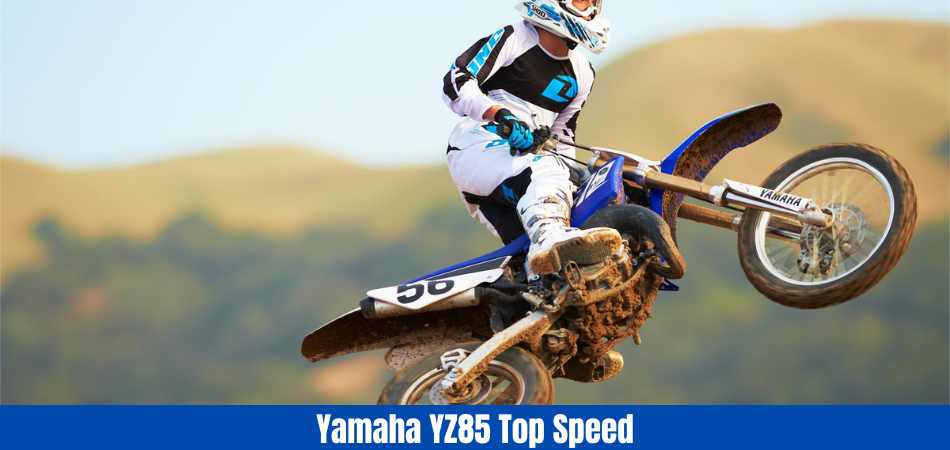
You can usually find this information in the owner’s manual, so make sure your tires are inflated to the recommended level so that they won’t hold you back.
4. Adjustment of the gear ratio
A second method of increasing top speed is to adjust the gear ratio on your bike. As gear ratios increase, acceleration will increase, but maximum speed may be limited due to increased friction between gears.
A lower gear ratio, on the other hand, will provide more torque but may limit acceleration. Find a gear ratio that gives you good acceleration and high top speeds by experimenting with different ratios.
5. Cleaning of air filters
It is also possible to increase your bike’s top speed by cleaning and replacing your engine’s air filters regularly.
An air filter helps prevent dust and debris from entering an engine’s combustion chamber, which can reduce power at high speeds due to restricted airflow. You may need to replace your air filter if you notice a decrease in power when revving up past certain RPMs.
What are the Safety Features Available in the Yamaha YZ85?
Yamaha’s Yamaha YZ85 boasts a powerful engine and adjustable suspension system, making it a great choice for young riders. An electric starter is also included in this vehicle as its safety features.
So it can be started in cold weather even with dual disc brakes. Besides providing plenty of control, the handlebars are also designed to be comfortable while riding on rough terrain.
How Much Does the Yamaha YZ85 Cost?
It costs $4,799 MSRP for a brand new YZ85, but used ones go for considerably less. It depends mainly on the model year and condition of the used vehicle to determine a used vehicle’s value.
The value of an older or poorly running YZ 85 may be only between 800 and 1200 dollars, but a good and well-running YZ 85 may be worth between $2000 and 3000 dollars.
What are the Pros and Cons of the Yamaha YZ85?
The pros and cons of the YZ 85 are listed below if you haven’t decided if you should buy one. This will help you avoid wasting your time and money on a bike that you don’t need.
Pros of Yamaha YZ85
- It’s a great motocross bike for kids 9-15 years old who have experience riding race bikes
- Such a small bike has a lot of top-end horsepower
- Handles well and is lightweight
- Rebuildable engine with a simple design
- For newer riders/racers, this engine has more mid-range power and low-end torque
- A great deal of durability and reliability
- There are a lot of parts available at reasonable prices (for the most part).
Cons of Yamaha YZ85
- Kids shouldn’t use this dirt bike as a beginner
- Low-end torque makes learning clutch work at slow speeds more difficult
- Due to engine and suspension characteristics, this dirt bike is one of the worst for trail riding
- Lack of maintenance can result in rough-looking used bikes
Major Competitors of Yamaha YZ85
There are other Japanese manufacturers who didn’t stay behind even though the bike is very powerful and develops more horsepower than expected. Since they know how important it is for a rider to maintain a certain line throughout their riding years, they have to be impressed from the beginning.
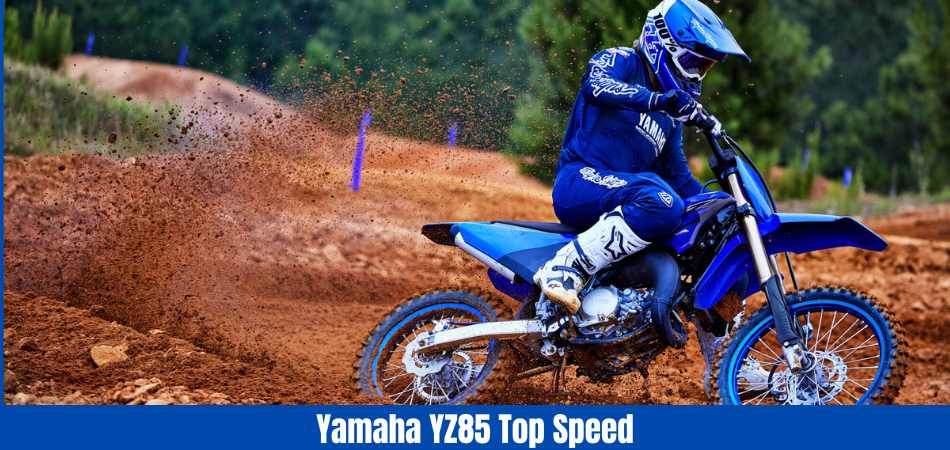
Kawasaki introduced us to the KX85 (an even cheaper bike with as much to offer as the Suzuki) in order to gain a certain clientele. Honda produces the CR85R (probably Yamaha’s largest competition), Suzuki entered the market with its RM85 (a cheaper motorcycle with a lot to offer), and Kawasaki with its RM85 (a cheaper motorcycle with a lot to offer).
1. The KTM 85 (Small wheel or Big wheel)
There are two types of KTM 85s: small wheels and big wheels.me in the motocross world. Both the small wheel KTM 85 and the big wheel KTM 85 are available. There are cheaper bikes in this class, but this one is more expensive.
2. The Kawasaki KX 85
There is a little to be desired when the Kawasaki KX 85 is compared to the Yamaha YZ 85. When negotiating corners, it takes a bit more clutch power. However, it still consumes a lot of energy.
3. The Suzuki RM 85
The Suzuki 85 dirt bike is the most affordable of the Japanese four dirt bikes in this class. Its main selling point is not its only one. It is made of durable parts. In addition, the throttle response on the Kawasaki is snappier.
Is the Yamaha YZ85 reliable?
In terms of a race bike, it is actually reliable, but it is highly dependent upon a few factors. How do you maintain your dirt bike? Where do you ride? How do you maintain your dirt bike?
When you ride a lot in sand or mud, parts will wear out faster since the sand gets into everything. Dirt that is loamy or hard-packed, on the other hand, is likely to last longer.
How Long Will the Yamaha YZ85 Last?
However, if you race motocross wide open all the time, you will have to rebuild the engine more often. Hard riding might cause the top-end to lose compression and power after 10-20 hours.
If you ride casually, you could get 100+ hours out of your YZ 85 before having to rebuild it. Proper maintenance makes this even more true.
Clean air filters, regular oil changes, and using proper oil mixtures are all part of proper maintenance.
Is the Yamaha YZ 85 Good for Beginners?
You shouldn’t start riding dirt bikes on this bike if you’re a first-timer, for numerous reasons. In learning how to use the clutch and throttle, you’ll find the engine to be abrupt and peaky.
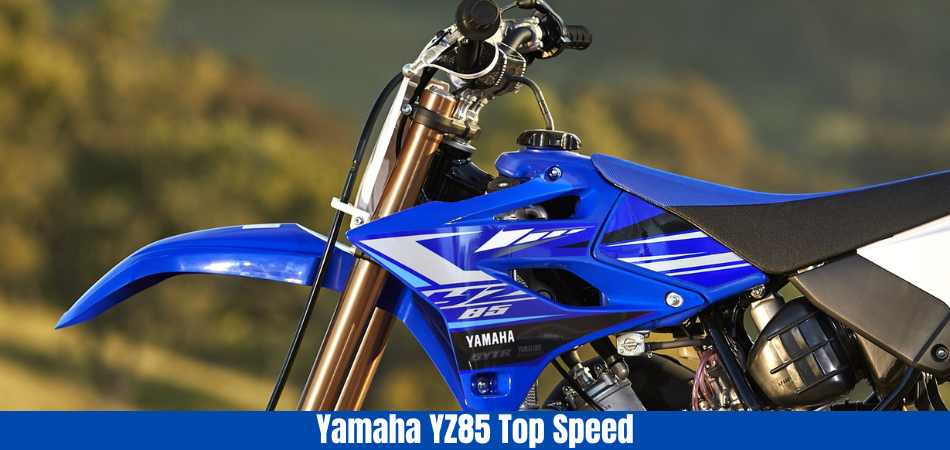
Due to its motocross racing and jump-focused suspension, it’s pretty stiff if you weigh less than 100 pounds. Beginners might find the TTR 125 to be a good choice.
Can You Trail Ride with a Yamaha YZ 85?
It can be ridden on the trails, but it’s not the best dirt bike for this kind of riding. When I first started riding dirt bikes with clutches, I had a CR80, which is a Honda version of the YZ 85. It was a terrible bike for trails and forest riding.
There was not enough torque (power) if you let the RPM drop too low, so it would not accelerate. The clutch was somewhat difficult to use, especially since I am a new rider.
Conclusion: YZ 85 Top Speed
In essence, the YZ85 embodies the spirit of motocross. Unlike most dirt bikes designed for beginners, this Yamaha is not meant for beginners. It is still possible for kids aged 10-12 to gain great control of the bike with the higher seat height. Obviously, it depends on how big the child is and how much experience he or she has riding.
Throughout the years, the shroud of this bike has been significantly improved. Yamaha’s commitment to improving the technology of this bike is evident in this achievement. The YZ 85 is recommended for achieving speeds up to 65 mph (105 km/h).
Read more of our articles here.
Read Also: 2023 Yamaha YZ85 Motocross Motorcycle
FAQs
1. Is the YZ85 powerful?
With its high compression ratio and close ratio 6-speed transmission, the YZ85 provides outstanding acceleration and race-winning power.
2. Is a YZ85 a 6-speed?
Powered by an 84.7cc water-cooled, two-stroke, reed valve inducted engine, the 85 has a six-speed, constant mesh manual transmission and a wet clutch.
3. Is YZ85 good?
Sure! Overall, the power is snappy, has good carry-through, and has more than enough oomph to handle 135 pounds.
4. How heavy is a YZ85?
Wet – 161 lb. The vehicle’s wet weight includes all standard equipment, all fluids, including oil, coolant (if applicable), and a full tank of fuel. Optional or accessory weights are not included.
5. Is a YZ85 a full-size bike?
In a small package, the YZ85 offers big-bike specs. A Yamaha Power Valve System (YPVSTM) increases the low- and mid-range power of the 85cc liquid-cooled, two-stroke engine.
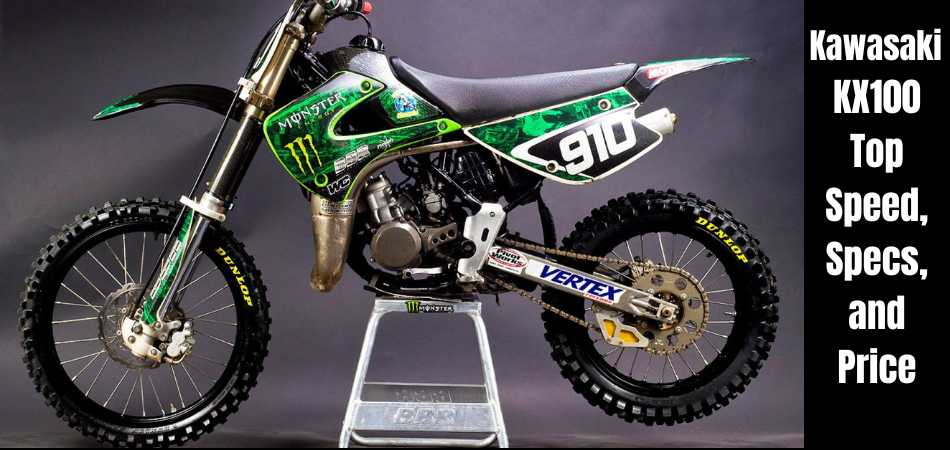
Featuring 19-inches on the front and 16-inches on the rear wheels, the Kawasaki KX100 is a youth motocross motorcycle. 99cc single-cylinder engine with 2-strokes and a 99cc displacement powers the machine. KX100 Top Speed is around 60-70 mph.
The gearbox is a full-size 6-speed, and the clutch is a multi-disc wet type. KX100 offers good performance and decent top speed. Lime Green is the only color available for this motocross, which starts at $4,649.
If you want to increase the top speed of your KX100, there are several modifications you can make. Adding a performance exhaust can reduce back pressure and increase horsepower.
It’s also possible to reduce weight and improve acceleration by installing lightweight parts like rims and handlebars. You can also increase your top speed by up to 10 mph by changing the stock tires for ones with higher speed ratings. Read the article to learn more about it.
Overview of Kawasaki KX100
Riders seeking an adrenaline rush will find plenty to enjoy on the Kawasaki KX100. Powered by a 99cc, two-stroke engine, it delivers an incredible amount of power and acceleration.
In addition, the bike has adjustable suspension settings that allow you to customize your ride according to your riding style and terrain.
Despite its lightweight frame, its large seat provides comfort even when riding for long periods of time. Its bold graphics and green livery are sure to turn heads wherever you go!
Kawasaki KX100 Specs
1. Engine & Transmission
There is a 99cc, single-cylinder, 2-stroke engine on this motocross. Powered by two strokes, it is equipped with a 28 mm Keihin carburetor. The engine is liquid-cooled and has a CDI ignition system with digital advance.
Featuring a multi-disc manual clutch and a 6-speed return shift-type transmission, the Kawasaki KX100 features a 6-speed return shift-type transmission.
2. Top Speed & Performance
KX100’s 2-stroke powerplant features an exhaust power valve system that gives it a broader powerband. In terms of power and torque, Kawasaki has not yet revealed any details about this motocross. A single-cylinder engine provides adequate power that bridges the gap between mini and full-size dirt bikes.
Kawasaki claims that the KX100 can reach speeds of 68 mph. The top speed of a rider may vary based on their weight and the conditions of the ride.
3. Body & Suspension
In terms of chassis, the Kawasaki KX100 has a perimeter-type frame with subframe members. Like the Kawasaki KLX 110R, its frame is lightweight and made of high-tensile steel. The front fork is an inverted telescopic 33 mm unit with 20 ways of compression damping. Gas-charged Uni-Trak shock absorbers with piggyback reservoirs come standard on the KX100.
There are 24 compression and 21 rebound damping adjustment points on the rear suspension.
4. Brakes & Wheels
With disc brakes on both wheels, the Kawasaki KX100 has an impressive amount of stopping power. There are 220 mm petal disc brakes on the front wheel and 184 mm petal disc brakes on the rear wheel.
Two piston calipers are on the front disc brake, while one piston calipers are on the rear disc brake. There are 16-inch wheels on the rear of the Kawasaki KX100, and 19-inch wheels on the front. The front tire has a size of 70/100-19, while the rear tire has a size of 90/100-16.
5. Dimensions
The ready-to-run condition of this motocross from Kawasaki weighs about 169.7 lbs. The seat height of the Kawasaki KX100 is 34.3 inches.
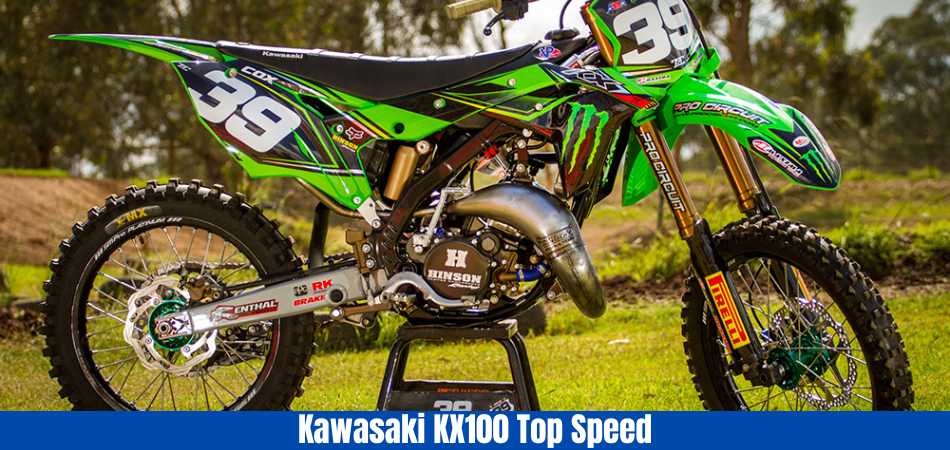
The ground clearance on this motocrosser is 13 inches. There is a capacity of 1.32 gallons in its fuel tank, and its wheelbase is 51.6 inches.
6. Kawasaki KX100 Price
For the Lime green color variant, the Kawasaki KX100 starts at $4,649 in the United States. There are no direct competitors to the KX100 in the 100cc segment at the moment. Nevertheless, it has indirect competition from the Honda CRF150R, the 2024 KTM 125 SX, and the Husqvarna TC 85.
Kawasaki KX100 Top Features
- Frame with subframe member of perimeter type of high tensile steel
- System for ERGO-FIT
- Handlebar mounts with six positions
- Front-wheel with 19-inch spokes
- Rear wheel with 16-inch spokes
- Single-cylinder, two-stroke engine
- A liquid cooling system
- Valve for exhaust power
- Keihin carburetor 28 mm
- Digitally advanced CDI ignition
- Fork with inverted telescopic 36mm
- Front suspension with a 20-way compression damper
- Piggyback reservoir gas shock with Uni-Trak gas charge
- The rear suspension features 24-way compression and 21-way rebound damping
- Preload adjustment for springs
- Brakes with dual pistons at the front
- Single-piston rear disc brakes
- Gearbox with 6-speed return-shift
- Clutch with multi discs in wet conditions
Additional Features of Kawasaki KX100
- A large radiator provides cooling performance.
- Flywheels with earth magnets are used to improve engine response
- The Nikasil plated cylinder assures enhanced durability
- A scavenging port shape boosts power
- Crankshaft resin blocks primary compression uplift.
- A bridge between the intake and exhaust ports also provides great seizure resistance.
- Carbon fiber with a 45degree angle has the blessing of flexibility
- Exhaust port windows increase port velocity easily.
- KIPS adds increased horsepower and torque to the vehicle
- The simp-type valve provides optimum damping
- This bike has wide footpegs that provide outstanding performance.
Kawasaki KX100 Top Speed
There have been comments about KX100 that say you should take an aeroplane if you want to go faster in the air, but if you want to be the best on the road, choose KX100.
What do you think the purpose of this statement is? This beast has a remarkable speed limit, that’s why.
The top speed of the KX100 is 60-70 mph, which is pretty decent for a two-wheeler. Several factors influence the limit, including wind, surface, road condition, altitude, and maintenance. In some cases, the rider’s weight has a significant impact on the speed.
The reason why it differs from user to user is because some users had experiences of 75-80 mph.
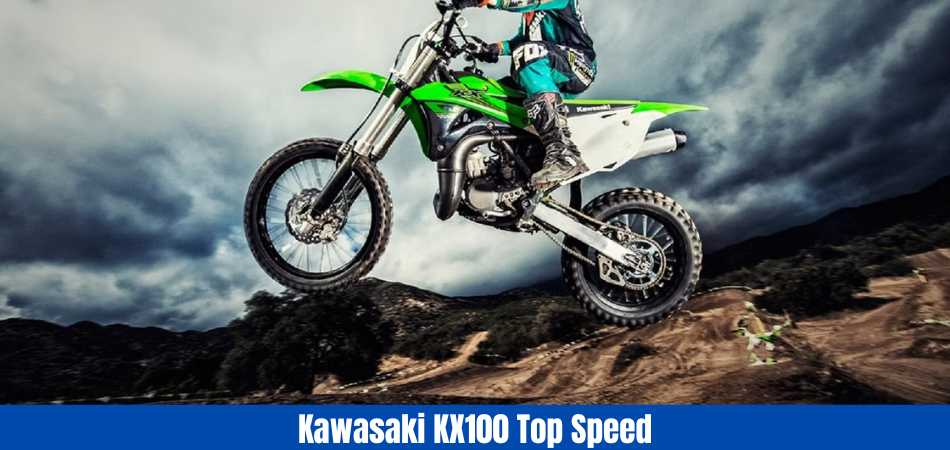
With six-speed gears, the KX100 has an exciting top speed. If you own a motorbike, you know how important it is to have multiple gears to enhance the speed.
It has an additional 5th and 6th gear, considered overdrive gears, which allow excessive speed while keeping engine revolutions low. It’s a win-win situation.
Major Competitors of Kawasaki KX100?
The Kawasaki KX100 stands out from other two-stroke bikes of similar size, such as the Yamaha YZ85 or Honda CRF150R. With unmatched acceleration and power, it is perfect for experienced riders who seek more from their rides.
Additionally, you can customize your ride based on terrain or riding style by adjusting the suspension settings. Also, it stands out in any group of riders because of its bold graphics and stylish design!
Overall, the Kawasaki KX100 is an excellent choice for dirt bike enthusiasts who want a powerful, high-performance machine. You can customize your ride using its adjustable suspension according to your needs and preferences, thanks to its 99cc engine. Its eye-catching design and vibrant green livery will definitely turn heads wherever you ride!
You can’t go wrong with the awesome Kawasaki KX100 if you want to go off-road without breaking the bank!
How to Increase Kawasaki KX100 Top Speed?
Here are some tips on how to increase the speed limit of KX100 without spending a lot of money at the mechanic shop. Even so, these hacks are for those with motorbike experience or at least a basic understanding. Go ahead and do this on your own if you think you can!
When applied properly, these tricks will surely increase your bike’s speed by 4-5 mph. Let’s take a look!
1. Change the gear ratio
Changing your bike’s gear ratio will change the number of revolutions a driveshaft makes per revolution of the wheel. Especially if you purchase a TLD for the predator, it will do wonders.
Also, you can increase the speed of the quad by dropping one tooth from the front 14T and three teeth from the rear 38T. Yes, you can reverse the acceleration and top speed if you’re interested.
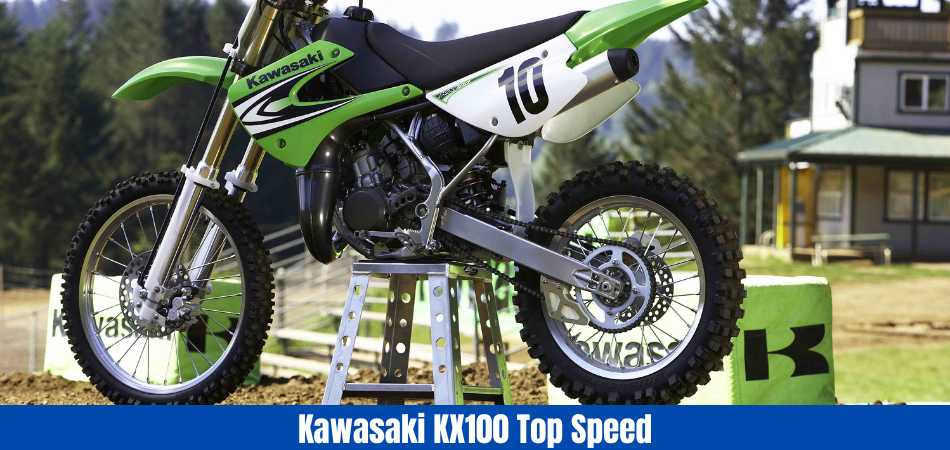
The only thing you need to do is increase the front gear to 15T. It’s done!
2. Replace the carburetor
If you want to increase the top speed of KX100, you should definitely change the carburetor part. We all know that the carburetor stores air and fuel for the bike.
You can reserve more fuel and air if you upgrade that space, which will increase your vehicle’s horsepower.
As soon as the horsepower is updated, the top speed limit will be increased as well!
To ensure more fuel delivery, throttle response, and increased power, carbs are always a good investment. Additionally, do not cut the springs of the purchased carbs, since this won’t increase their speed!
You should also look out for some signs that indicate the carburetor needs to be replaced. Like when,
- Low fuel efficiency is caused by it
- It idles too fast on the bike
- Trying to start it floods
- At low speeds, the bike stalls
- More load causes hesitancy
Immediately replace the carb if these issues are observed!
3. Install the Bog Bore Kits
The bog bore kit makes a huge difference, but you won’t feel it until you attach it to your bike.
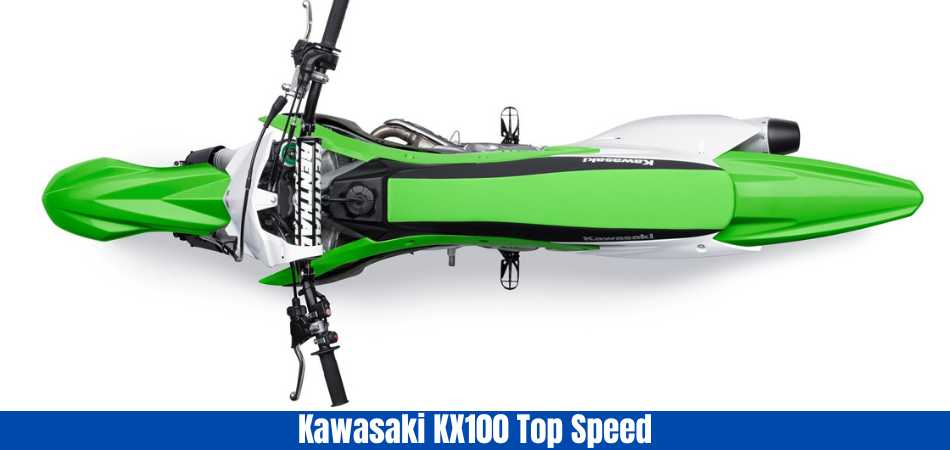
You will get more power from your KX100 if you have an oversized cylinder and piston. Furthermore, it creates large spaces which allow for large valve openings that allow more air and fuel to enter the cylinder.
Adding a big bore to a short-stroke engine can also increase horsepower while revving high. As a result, it will increase the speed limit!
4. Check the carb needle
Last but not least, make sure the needle of your carb is lifting. If it doesn’t elevate, try to clean it every day. If the performance is disrupted, it will limit the speed when riding the quad.
What are the Pros and Cons of Kawasaki KX100?
This motorbike’s pros and cons will be discussed now, so let’s conclude with an honest review!
Pros of Kawasaki KX100
- A reliable bike, the KX100 is without a doubt. With just oil and air filter changes, you can ride on it for like 60 hours. A long ride doesn’t require anything else.
- Having multiple gears has the advantage of allowing the speed limit to be increased significantly. It is especially important to look for the overdrive ones so that you can easily drive on any terrain.
- A dirt bike’s weight is the most important factor to consider. Due to its lightweight design, you can ride it at high speeds. For any type of sports purposes, Kx100 will be absolutely perfect
- To ensure maximum control, wide foot-pegs are essential. You don’t have to worry about unwanted risks or accidents while riding this bike.
- For young riders out there, the 99cc engine on the Kx100 is a game-changer. Its engine is extremely durable and flexible, so you can ride for hours without any issues.
Cons of Kawasaki KX100
- This is easy to ride on any surface due to the undersized wheels. However, the setup of the wheels can be changed. Due to the tiny wheels, the tires allow you to drive into obstacles instead of floating over them. After a few rides, you’ll get used to it, but it’ll take time.
- It doesn’t explain how to set up the device in the instruction manual. Since it’s a dirt bike, starting it up can be challenging. There are days when it will sit idle, and there are days when it won’t.
- You may stand most of the time when riding a dirt bike, but if you enjoy long trail rides, the seats can be uncomfortable!
Conclusion: Kawasaki KX100 Top Speed
There is only one 100cc 2-stroke motocross on the market currently, the KX100. Featuring an exciting 2-stroke engine, it offers an appropriate power bump for amateur riders.
This motocrosser features high-performance suspension setups on both ends. As a bridge between mini and full-size motocross bikes, the Kawasaki KX100 is perfect for beginners.
Read more of our articles here.
Read also: 2024 Kawasaki KX100
FAQs
1. What is the top speed of the Kawasaki KX100?
The Kawasaki KX100 can reach a top speed of approximately 75 miles per hour (120.7 kilometers per hour).
2. How does the Kawasaki KX100 compare to other dirt bikes in terms of top speed?
KX100 offers a balance between power and speed that is suitable for motocross and off-road enthusiasts, with a top speed that is competitive in its class.
3. What factors influence the top speed of the Kawasaki KX100?
The performance of the engine, gearing, aerodynamics, and the overall design of the bike all contribute to the top speed. Top speed can also be affected by modifications and aftermarket parts.
4. Is the Kawasaki KX100 suitable for high-speed racing?
The Kawasaki KX100 has been designed specifically for off-road racing, making it a great choice for high-speed competitions.
5. Can the Kawasaki KX100’s top speed be increased through modifications?
Modifications such as aftermarket exhaust systems, gearing changes, and engine enhancements may increase top speed, but they may also negatively affect overall bike performance.
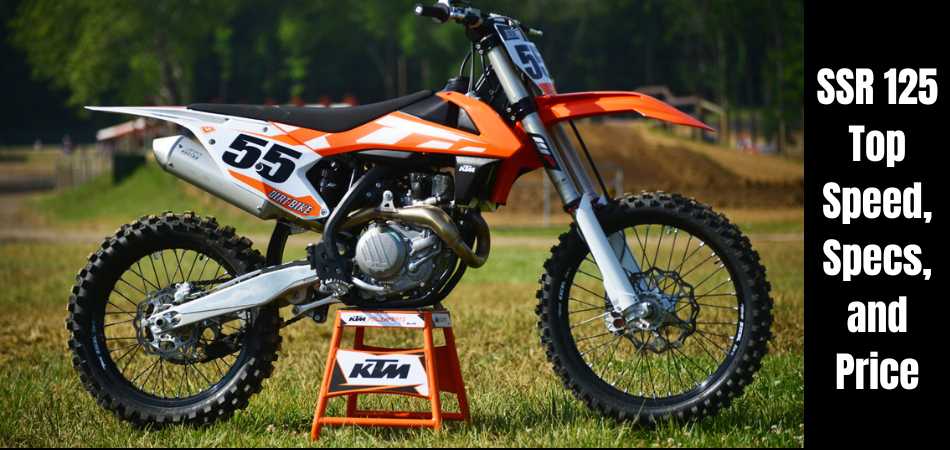
Many underestimate the SSR 125 since its frames are identical to the CRF. However, only after sitting and riding on this pit bike will you be able to detect the difference. It originates in China and provides superior wheel and engine designs at a low cost.
Whether you’re a teen or an experienced rider, you can get the most out of this baby. However, it is quite popular in the novice group.
That is hardly a surprise. Because of its smooth handling, compact size, and strong engine, a novice racer may get the “pro” experience without taking on riskier alternatives.
That is why we have conducted extensive research to provide you with an in-depth look at the SSR 125 Top Speed, Specifications, and Review. Let’s dive in.
SSR 125 Overview
The SSR 125 Pit Bike is an excellent way to begin off-roading and riding. It offers all the advantages of a full-sized bike, such as adjustable suspension and electric start, but with a smaller frame that’s suitable for smaller riders.
The SSR 125 is made durable with high-quality components like an aluminum frame and steel rims, making it equipped to conquer any terrain. Furthermore, its four-speed semi-automatic gearbox makes shifting straightforward.
With SSR bikes, you receive more than just a bike; you get confidence in your ride because of the high-quality construction and engineering that goes into each SSR product.
Whether you’re searching for a beginner off-road ride or something more advanced, SSR is the way to go. SSR offers something for everyone! Get out there and have fun with SSR. You will not regret it!
SSR 125 Specs & Features
1. Engine
Depending on the model or trim, this pit bike may come with a YX™ or BangEn™ 4-Stroke engine based on Honda technology coupled to a 22-mm Mikuni carb. SSR pit motorcycles include a two- or three-position manual petcock that regulates fuel flow from the gas tank to the SSR 125 carburettor and helps with cold starts. Petcocks with two positions are on the left side of the carb, while those with three positions are on the right.
2. Drivetrain
Power is transmitted via a four-speed manual or automatic gearbox with reverse. Shifting gears need completely disengaging the clutch to avoid serious damage to the clutch assembly or gearbox. Similarly, never downshift at high speeds to avoid a similar outcome.
3. Ignition
Except for the completely automated trim, all SSR 125 pit motorcycles require a kick-start. The kick-start lever is located on the engine case’s right side (back of the right footpeg). Depending on the trim, the SSR 125 has one of two engine-off switches: an ignition kill button near the left handgrip or an on-off thumb switch in the center of the handlebars.
4. Tires & Brakes
Special trims, such as the SR125B2 Pro (grandfathered) and SR125TR/TR-BW, come with 60/100 – R14/12 front and 80/100 – 10 rear tires from the factory.
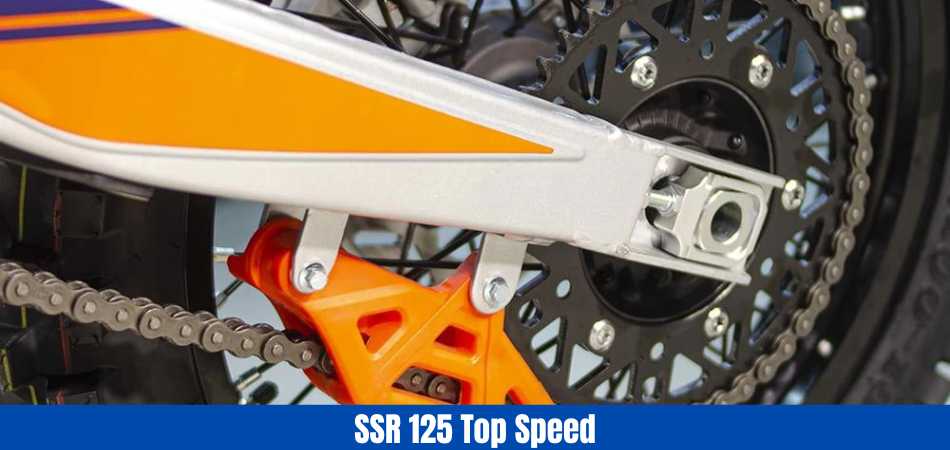
All other versions (including manual and automatic transmissions) feature 2.75 – 14 front and 3.0 – 12 rear knobby. Stock rubber remained intact, with the exception of the current SR125TR trims, which received tubed 100/70 R17 (front) and 100/90 R14 (rear) tires placed on steel wheels.
It’s unclear whether the factory brake size is 190 mm. According to research, disc diameters might range from 190 mm to 240 mm, depending on whether you want to replace the original tires.
5. Suspension
While the front hydraulic fork is not adjustable on some versions, the rear shocks compensate with 6 inches of wheel travel, resulting in bike stability and consistent wheel alignment. Standard SSR 125 pit motorcycles include an A-type alloy swingarm, whereas sportier variants have a straight swingarm. Except for the SR125TR and SR125TR-BW versions, the remainder uses 275-mm monoshocks.
What is the SSR 125 Top Speed?
The 125cc four-stroke engine can reach speeds of 55 to 60 mph, or 61 to 80 mph. The power output is around 7.3 horsepower @ 7500 RPM. If you’ve done any study on the horsepower and speed of motorcycles, you’ll see that the speed is rather good for a 125cc engine.
The four-stroke SOHC engine contributed to this increased speed. Normally, 125cc engines use a simple 2-stroke engine. However, the SSR makers distinguish themselves in this area. Furthermore, the engine’s peak speed increases as a result of the additional strokes.
How To Increase The SSR 125 Top Speed?
If you wish to race this Chinese pit bike, you may be disappointed with its performance. But do not worry. There are modifications available that can significantly enhance speed.
1. Change the Sprocket
You may use a 17-tooth sprocket instead of a 15-tooth one. An increased number of teeth on the sprocket will immediately increase your bike’s speed. How do you do that?
You’ll need an eight-millimeter 5/16 socket with a 10 mm wrench, a 19 mm socket, and 12mm, 13mm, and 17mm wrenches. Simply replacing the front sprocket will allow you to enhance the speed considerably. You do not even need to make any changes to the back one.
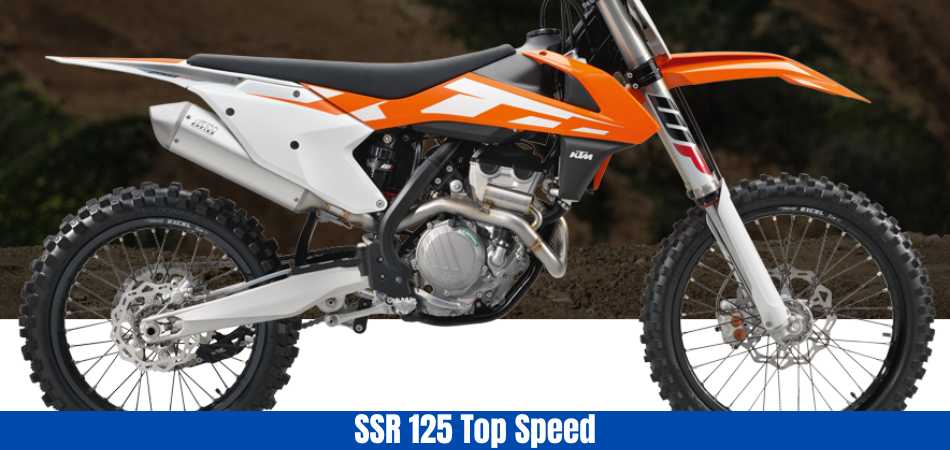
For maximum speed, use a larger sprocket in the front and a smaller sprocket in the rear. However, you will obtain more torque if you adjust the formula and use a larger rear sprocket and a smaller front sprocket. However, it was not at the desired speed.
So we should stick to the front sprocket exclusively. Even little adjustments to the sprocket tooth will result in a significant change.
A reminder: if you change the sprocket on your pit bike, you must obtain a new chain. Although the old chain would cover one extra tooth, it would be prudent to replace the chain entirely.
2. Air Filter And Exhaust Mod
The after-market air filter is the first mod item to be released. And there is a good explanation for it. Consider air and gasoline to be your engine’s dietary sources. The more food you can gather, the more combustion or power it can produce. It is that easy.
That being said, each bike has a unique set of air intake, exhaust, and system controls. Simply insert a new aftermarket air filter and exhaust into the system and experience the magic. Now, your bike can breathe like an Olympic swimmer.
3. Lighter Wheels
How can the wheels be turned faster? Well, by making them go on a diet. A lightweight wheel is easier to handle and travels quicker. Furthermore, when the lightweight wheels meet a bump on the road, the suspension is easier to return to its previous position.
Unfortunately, this is not the case with heavier wheels. As a novice, you’ll want a lighter wheel for improved handling.
The negative is that the metal is thinner and will deform more quickly. If that is not a problem, we recommend purchasing lighter wheels for this SSR pit bike.
Other Factors Influencing SSR 125 Top Speed
A dirt bike’s speed can be influenced by a variety of factors, including terrain type, topography, wheel size, and suspension configuration.
Terrain type may have a big influence on speed. For example, riding on sand or loose mud might slow a bike down owing to greater resistance, but a hard, flat surface, such as tarmac, can allow for faster speeds.
Topography also plays a part. Uphill riding requires more force to counteract gravity, which might slow the bike down.
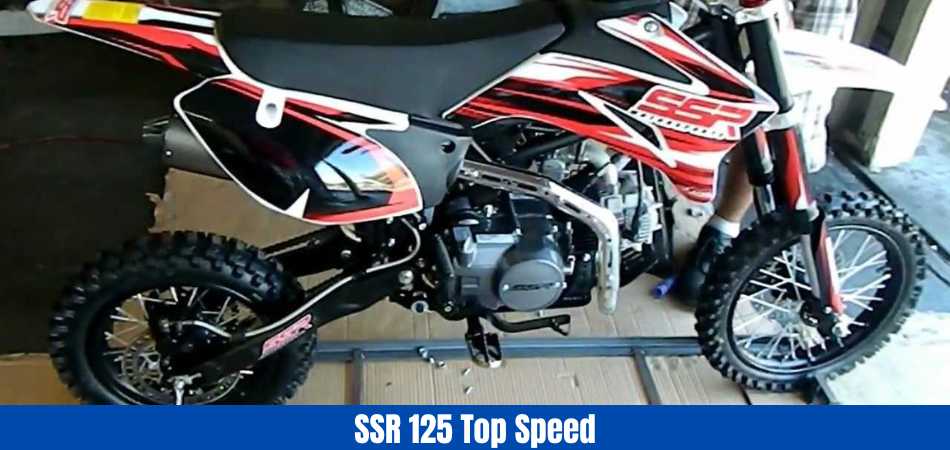
In contrast, downhill situations can enhance speed since gravity helps force the bike ahead.
Wheel size might also affect speed. Larger wheels can go farther with each rotation, potentially improving speed. However, they require more force to turn, which may affect acceleration.
The suspension arrangement can also influence speed. A well-tuned suspension may aid in maintaining stability and traction at high speeds, but a badly tuned suspension can cause instability and lack of grip, slowing the bike down.
SSR 125 Bike Cost
SSR 125 Pit Bikes are undeniably inexpensive. The cost of an SSR 125 Pit Bike varies based on the features and extras chosen, but costs typically start at about $600 for a basic model. If you want all the bells and whistles, SSR 125 Pit Bikes can cost up to $1500 or more. Whatever your budget, SSR offers a bike that will fulfill your requirements without breaking the bank. Begin your search today and see how economical SSR 125 Pit Bikes truly are.
What are the Pros and Cons of SSR 125?
Pros of SSR 125
- Bike maintenance is convenient.
- Its aftermarket components and the bike itself are fairly inexpensive.
- A full tank of gas equals 4-5 hours of straight driving.
- Maintenance is less time-consuming than that of a dirt bike.
- The SSR 125 is surprisingly lightweight for a pit bike, making it easy to travel.
- It is swift, and acceleration is smooth even with a heavy rider on the saddle.
- It may be used and enjoyed on narrower terrain compared to full-fledged dirt or MX bikes.
- The SSR is larger than dirt motorcycles like the KLX110L, providing riders greater knee space.
- Front tires, discs, and brake pads perform admirably in mud, dirt, asphalt, and other harsh riding situations.
- The SSR has a lot of torque and won’t stall, making it ideal for teaching beginners how to ride a manual.
Cons of SSR 125
- All nuts, bolts, and spokes require Loctite.
- Even while running singles, the rear axle bolt is prone to bending.
- Pit bikes, like the SSR, are not designed for harder terrain or aggressive riders.
- The connection point between the muffler and the exhaust pipe rattles when riding.
- Stock tires do not get the best performance from the bike on berms and jumps.
- The rear tires should be replaced with an MX knobby, which allows the bike to hook up much better.
- The 2019 SR125 Auto has been recalled owing to reported injuries caused by the failure of the front fork assembly. Although the problem has been resolved, the front fork problem persists on subsequent 125-cc versions.
After a year of riding, heavy riders can quickly bottom out their front suspension. Many off-roaders find the front shocks to be mushy even when they are brand new.
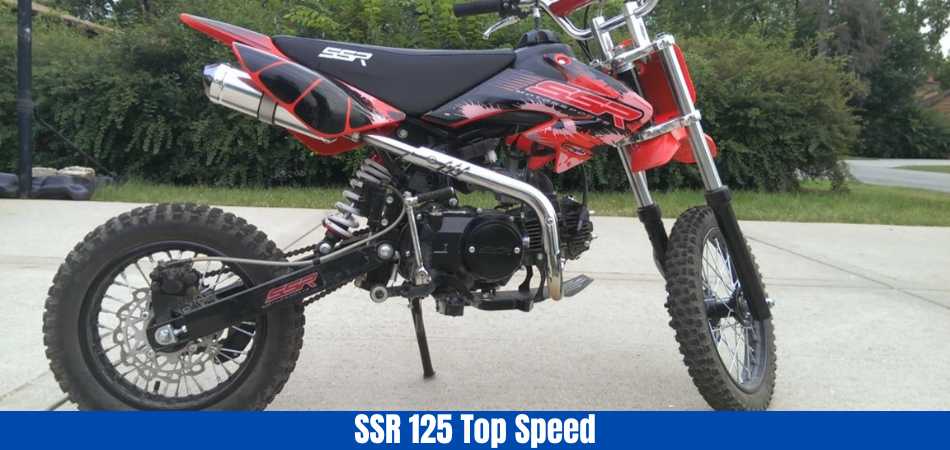
Stock footpegs, shift levers, and handlebars are a little fragile. For more stable handling, consider replacing your handlebars with 7/8″ Pro Taper handlebars (available on Amazon).
Unfortunately, the SSR 125 is receiving a lot of criticism on bike sites, which is owing in part to prior owners’ true experiences with the wheeler and in part to groupthink.
This should not come as a surprise. It’s understandable that champions like Jeff Willows dominate bike competitions on a buffer SSR when the bulk of what normal people get from the motorbike is bottomed-out shocks, clutch difficulties, and poor components.
Conclusion – SSR 125 Top Speed
In conclusion, the SSR 125 Pit Bike is a remarkable and competent motorbike that will exceed your expectations while rating high on the fun factor. It is cost-effective and low-maintenance, with a sporty yet practical look. While opinions on the two-wheeler vary, its performance is determined by driver skill, preference, and intended usage. You can transform this derided pit bike into a dream machine with regular maintenance and the correct modifications.
Read more of our articles here.
Read also: How Fast Does A 125cc Pit Bike Go?
FAQs
1. What is the maximum speed of the SSR 125?
The SSR 125 has a maximum speed of 60 mph.
2. Is the SSR 125’s top speed customizable?
The manufacturer typically determines the SSR 125’s peak speed, which may not be easily adjustable without aftermarket modifications. However, evaluating the legal and safety ramifications is critical before making changes.
3. How does the SSR 125’s top speed compare to other motorcycles in its category?
The highest speed of the SSR 125 is competitive in its class. However, real performance might vary depending on rider weight, terrain, and maintenance.
4. What variables determine the SSR 125’s peak speed?
The SSR 125’s peak speed can be modified by rider weight, terrain, wind resistance, and maintenance. Maintaining the bike’s ideal condition is critical for reaching its maximum speed.
5. Is the SSR 125’s highest speed adequate for off-road riding?
The SSR 125 is primarily intended for off-road use, and its maximum speed is appropriate for a variety of off-road terrains. Riders should follow safety recommendations and local rules.
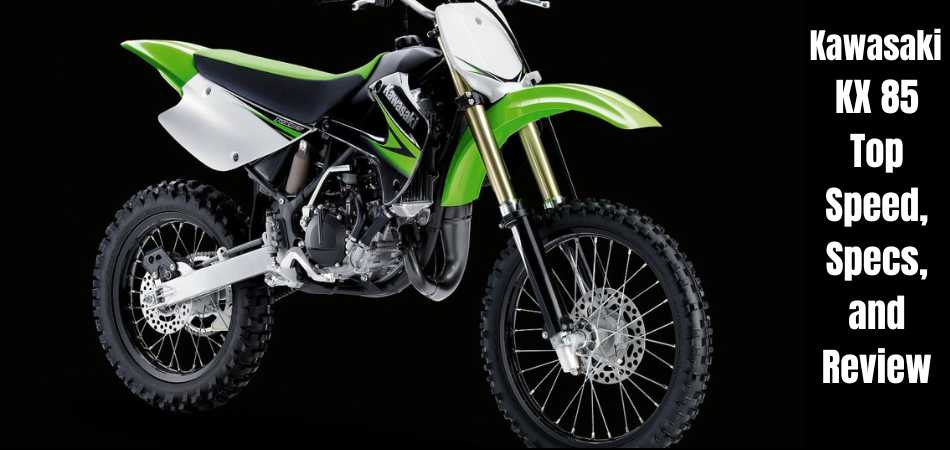
Designed for amateur riders, the Kawasaki KX85 is a two-stroke motocrosser. With a durable 84cc liquid-cooled 2-stroke engine, KX 85 top speed hits 80 miles per hour. It comes with a 6-speed manual transmission with multi-disc clutch. Only lime green paint is available on this updated motocrosser, similar to the Kawasaki KX 112. KX85 offers exceptional handling thanks to its championship-winning platform.
If you’re looking for the ultimate thrill for your kid, the Kawasaki KX 85 will take them to their limits! Which is the best way to get your child interested in dirt biking? The Yamaha KX 85 is the perfect bike for your child.
Kawasaki made a true legend with this motorcycle designed to absorb all bumps on the road. This bike has everything from its super-powerful engine to its convenient features to its reliable performance!
To make your decision easier, we’ve gathered all the information you need about KX 85 top speed, specs, and review. Let’s get started!
Overview Kawasaki KX 85
There is a high tensile steel perimeter frame and a rear subframe in the new KX85. Besides a new color scheme that mimics the Kawasaki KX100, there are no significant changes to the new model’s design.
Front wheel disc brakes have two piston calipers, and rear wheel disc brakes have one piston caliper. There is also a single shock absorber at the rear of the Kawasaki KX85 that is controlled by a uni-trak. With its front suspension, the vehicle offers 20-way compression damping, while its rear suspension offers 24-way compression and 20-way rebound damping.
Specifications of Kawasaki KX 85
Engine:
- Type: 2-stroke, liquid-cooled single
- Displacement: 84cc
- Bore x Stroke: 48.5 mm x 45.8 mm
- Compression Ratio: 10.9:1
- Fuel System: Keihin PWK28 carburetor
Ignition:
- CDI (Capacitor Discharge Ignition)
Transmission:
- 6-speed, return shift
Final Drive:
- Chain
Frame:
- High-tensile steel perimeter design
Suspension:
- Front Suspension: 36mm inverted telescopic fork with 20-way compression damping, 10.8 inches of travel
- Rear Suspension: Uni-Trak® single shock with 24-way compression and 21-way rebound damping, plus adjustable spring preload, 10.8 inches of travel
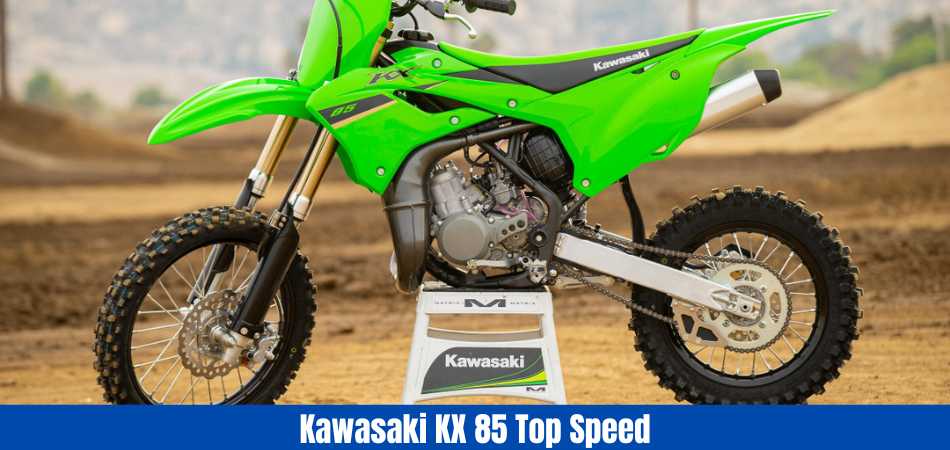
Brakes:
- Front Brake: Disc
- Rear Brake: Disc
Tires:
- Front Tire: 70/100-17
- Rear Tire: 90/100-14
Dimensions:
- Length: 71.7 inches
- Width: 28.9 inches
- Height: 41.5 inches
- Ground Clearance: 13.0 inches
- Seat Height: 32.7 inches
- Curb Weight: 169.7 lbs (wet weight)
Fuel Tank Capacity:
- 1.32 gallons
Features of Kawasaki KX 85
1. Winning Ergonomics
In terms of rider-focused designs, nobody comes close to us. For years, Kawasaki has upheld this reputation. They design their products with riders’ comfort and ergonomics in mind. There is a slim, minimalistic bodywork on the KX 85. Keeping optimal body positioning is possible while maneuvering tight spaces.
2. Adjustable Suspension
With the KX 85, you can easily handle jumps, bumps, and uneven terrain. There is zing in the zinger thanks to the suspension system. A Uni-Trak single-shock system and an inverted telescopic fork can be adjusted to suit your riding style. They can be fine-tuned to provide exceptional handling and control. Adapting to the conditions you encounter all the while.
3. Rugged Frame and Components
A perimeter and subframe member made of high-tensile steel. The chassis and components of the KX 85 are impressive. As a result of the reinforced clutch and transmission, the frame offers rigidity. Particularly useful in challenging conditions.
4. Power-packed Engine
It never fails to deliver an impressive power-to-weight ratio with the KX 85. The liquid-cooled engine provides excellent acceleration. Any terrain can be conquered with its punch.
5. Performance
Its championship-winning pedigree makes the Kawasaki KX 85 stand out. Throughout its history, it has dominated motocross tracks. The bike’s excellent handling and performance are largely responsible for this.
6. Braking
Slow down and reduce your speed. There is no problem with this assignment for the KX 85. It’s easy to slow down with the braking system. A maximum level of stopping power is dialed in for both the front and rear disc brakes, so there are no surprises.
7. Shocks and Comfort
With the KX 85’s superior suspension system, bone-rattling impacts are a thing of the past. The ride is smooth and controlled as it absorbs bumps and ups. There is only one suspension that can compete with this one: that of the KTM.
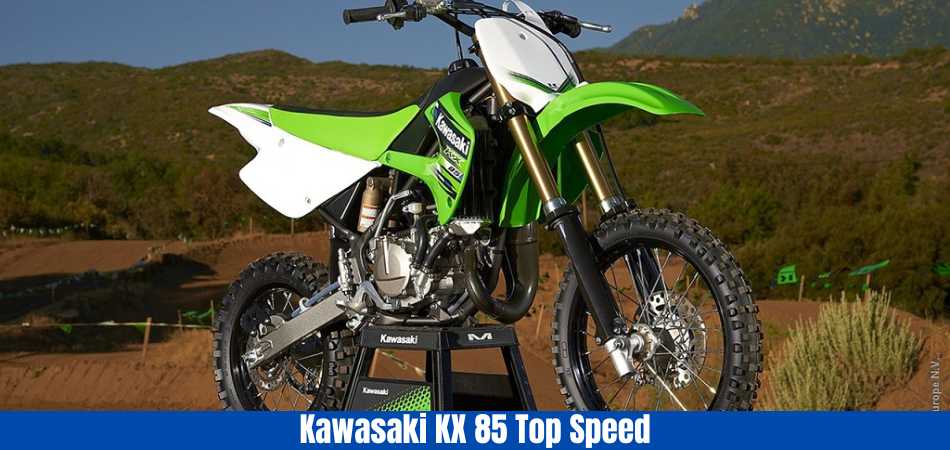
When tearing through the trails, comfort is also crucial. With its compact design, you’ll feel like you’re one with the bike. Even though many of the bike’s ergonomic features can be adjusted, taller riders may find it cramped.
Kawasaki KX 85 Top Speed
Kawasaki KX 85 hits 80 miles per hour when it comes to hitting the highest number on the gauge. The number is 129 kilometers per hour if you are a kilometer person.
The speed of dirt bikes is generally low. Dirt bikes aren’t like racing bikes, so you shouldn’t expect a fast pace from them. As a racing bike, the Kawasaki KX 85 has a much lower speed than racing bikes.
It is by no means less than this speed for a beginner rider. As well, the speed is intentionally limited so that even a beginner can learn and later take on any big dog.
Comparison to Other Bikes of the Same Class
Kawasaki’s KX85 competes with models from different brands, such as Yamaha’s YZ85, Honda’s CRF150R, and KTM’s 85 SX in the 85cc motocross class.
As with the KX 85, the Yamaha YZ85 is capable of 80 kilometers per hour or 50 miles per hour at its top speed.
On the other hand, the Honda CRF150R has a top speed of about 96 kilometers per hour or 60 miles per hour.
Also slightly faster than the 85 SX, the KTM 85 SX has a top speed of 65 miles per hour, or 105 kilometers per hour.
How to Increase Kawasaki KX 85 Top Speed?
It may not be possible to experience the thrill of riding off-road with the Kawasaki KX 85’s standard system if you like riding high-speed bikes. How about increasing your bike’s top speed by applying some techniques?
If you want to increase your top speed and enhance your dirt biking experience, there are a few ways you can do so. You can surely implement some of these useful ideas below.
1. Upgrade Your Factory Clutch
For novice riders, the dirt bike clutch is adequate. To boost the speed, you can use a race-specific clutch instead of the main clutch.
The horsepower version won’t give you this benefit. If you replace the existing clutch, you’ll notice a change in ground power, pickup, acceleration, and control.
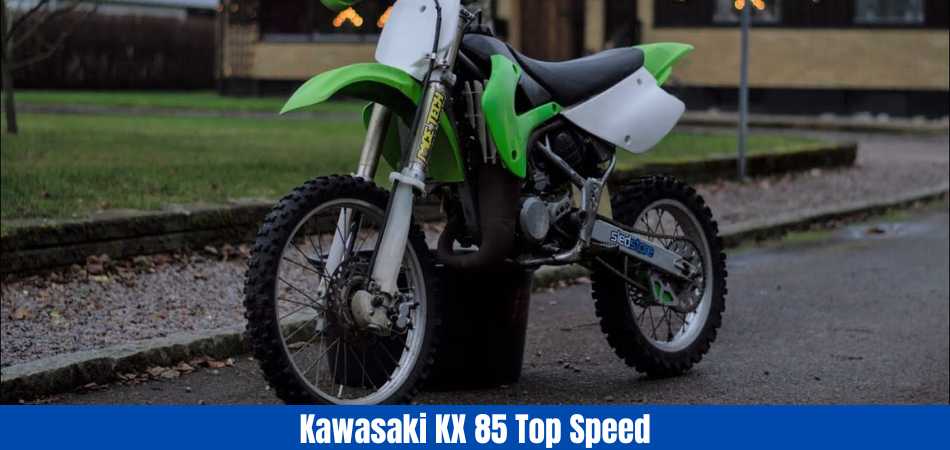
Your dirt bike’s speed and engine performance will improve as a result of these improvements.
2. Modification of the air filter
A performance-spec air filter is one of the best ways to improve your dirt bike’s performance. More air and fuel are burned as a result of the air filter component in the engine, which enhances the engine’s power.
By installing an aftermarket air filter on your dirt bike, you’ll improve filtration and keep your KX 85’s engine healthy. As a result, the mod will increase the speed.
3. Get rid of extra weight
As your bike carries more weight, it will run slower. The bike will waste power pulling more weight when it moves with something heavy. If you barely use parts of your bike, try removing them.
Use alloy wheels instead of spoke wheels and lighter exhaust systems. As a result, you will be able to ride your bike more efficiently on the road.
In addition, you can reduce your bike’s weight by about 5 to 6 kg by removing components like metal grab rails and center stands.
4. Gear swap
The last but not the least is to replace the existing gearing with race-proven gearing to make your bike run faster. Rather than affecting your top speed, it will enhance your ability to control it. Getting the most out of your bike is made easier with this convenient feature.
With the perfect combination of front and rear sprockets, the rider is able to achieve excellent top speed and acceleration.
When it comes to acceleration, smaller front sprockets and bigger rear sprockets work best. Your KX 85 will, however, reach its top speed faster if you apply the opposite technique.
What are the Pros and Cons of the Kawasaki KX 85
Pros of the Kawasaki KX 85
- The ability to shift gears more smoothly
- Cooling system for engines that is efficient
- Maintainable at a low cost
- The range of powerbands is decent
- An ergonomic design that is slim
Cons of the Kawasaki KX 85
- Taller riders may find it cramped
- Quality ride with rigidity
- Throttle response is a little delayed
Kawasaki KX85 Price and Competition
Currently, Kawasaki offers only one color and variant of this youth motocrosser in the United States. There is a $4,699 price tag attached to the Kawasaki KX85 in the United States.
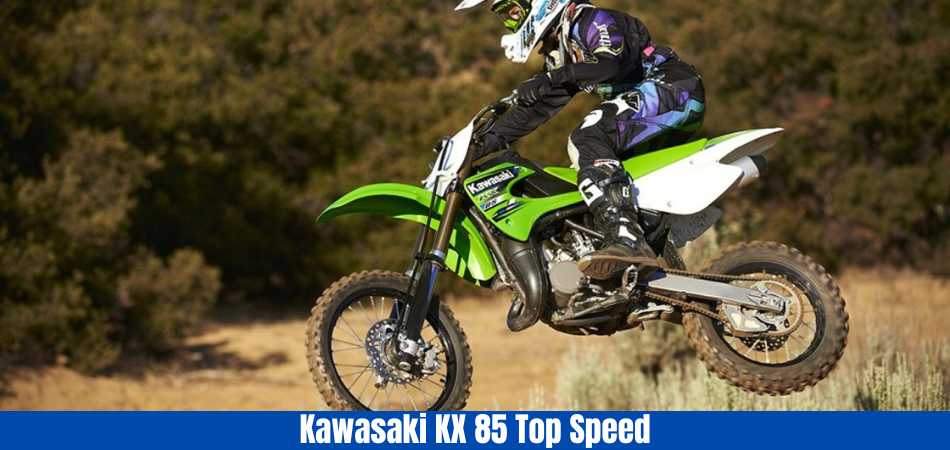
The 85cc category has plenty of motocrossers, so if you don’t like the KX85, you have other options. There are a number of alternatives to the KX85, including the Husqvarna TC 85, the Yamaha YZ85, the Suzuki RM85, and the KTM 85 SX.
The KTM 85 SX and Husqvarna TC 85 are the most expensive bikes in this comparison, priced at $6,549 and $6,749, respectively. Compared to the KTM twins, the Yamaha YZ85 costs $4,799 less. With a price of $4,399, the Suzuki RM85 is the most affordable 85cc motocrosser on the market.
Conclusion: Kawasaki KX85 Top Speed
A proven and reliable platform derived from Kawasaki’s championship-winning bikes is the basis of the KX85. Power and acceleration are proportionately delivered by its 2-stroke engine.
Handling and control are exceptional thanks to a responsive frame paired with a high-spec suspension setup. Budding racers can sharpen their shifting skills with the full-size gearbox with a manual clutch. Despite its attractive price tag, the Kawasaki KX85 makes a perfect motocrosser for amateurs.
Read more of our articles here.
Read also: 2024 Kawasaki KX85
FAQs
1. How much does a Kawasaki KX85 cost?
$4,699 is the price tag of the latest KX85 model.
2. How many gears does a KX85 have?
A wet multi-disc manual clutch is included with the 6-speed return shift gearbox.
3. Is a Kawasaki KX85 a 4-stroke?
Rather, this motocrosser is equipped with an exhaust power valve on its 2-stroke, 84cc engine.
If you are wondering that, between Jeep Body Lift vs Suspension Lift which method then consider reading this article. The installation of a body lift for your Jeep will increase its ground clearance and improve its control. While the jeep suspension lift will raise the elevation of the jeep’s suspension and thus offers the highest jeep lift options.
A body lift merely modifies how your Jeep’s frame is arranged. In addition, this will alter the height of your vehicle’s tires, but the suspension system must remain unchanged.
On the contrary, a suspension lift modifies both the chassis and the suspension system. Moreover, it will also make it simpler for you to install larger and taller tires on the vehicle without the concern of hitting any obstacles along the way.
However, suspension lifts and body lifts both provide a higher ride and space for larger wheels and tires, but they differ in cost, the center of gravity and handling adjustments, and ground elevation. So which choice should you make?
In this guide, we will compare the Jeep Body Lift vs Suspension Lift to ensure you can make a smart choice regarding which will perform best for your Jeep!
What is a Suspension Lift?
A suspension lift raises your vehicle off of its original frame with an aftermarket part, allowing you to get better clearance while driving off-road and to get over obstacles more easily.
A suspension lift installs very easily and requires very little modification to your Jeep’s body or frame. You won’t need to replace any steering system components either, lowering your overall installation costs.
Normally, most add-ons aren’t too concerned about ground clearance when seated in their highest position, but this could be an issue for some.
What is a Body Lift?
This form of modification increases the clearance of your vehicle and will give you more confidence when driving off-road. Body lifts extend the frame of your vehicle to allow you to install taller tires and wheels.
There are many benefits to body lifts, not the least of which is that they are easier to install and cost less than suspension lifts. There is no need to purchase additional parts, and taller tires can usually be installed at the same time without having to replace your stock wheels.
Drivers who already have large tires on their cars but aren’t satisfied with the ground clearance may benefit from this choice.
Major Difference: Body Lift vs Suspension Lift Jeep
Jeep owners constantly seek new methods to enhance their vehicle’s ability. There is a significant distinction between body lifts and suspension lifts for jeeps. Suspension lift systems offer more advantages than jeep body lifts since they can assist with trail clearance and road obstructions.
A body lift is an inexpensive and simple method to add height to a Jeep. This lift utilizes spacers across the frame and body plates to raise the body of the Jeep off the frame. This can assist you in achieving your ideal lift and add approximately 1 to 2.5 inches to your height.
A Jeep suspension elevation, on the contrary, may raise your vehicle’s travel height by up to 4 inches! A Jeep suspension upgrade replaces the vehicle’s hydraulics and stock struts. This increases the distance between your vehicle and road obstacles, such as pebbles and trunks of trees on unpaved roads.
Price is one of the most significant advantages of body lift over suspension lift. Body lift systems are less expensive than suspension lifts, and they can be installed in your garage with just a few tools.
What Are Some Pros and Cons of Body and Suspension Lift
Pros of Body Lift
- Installing a body lift is inexpensive and simple.
- It provides a small gap between tires and fenders.
- When used with large tires, it prevents friction problems.
Cons of Body Lift
- It does not significantly enhance road performance as anticipated.
- It makes the center of gravity higher.
- It creates an obvious gap between the body of the Jeep and the frame, rendering your Jeep ugly.
- If you use a conventional gearbox Jeep without modifying the selector opening, you may encounter gear-shifting issues.
- After adding body lifts, electronic wire connection lines, and steering component issues may arise.
Pros of Suspension Lift
- It provides the capacity for massive tires.
- It also permits enhanced handling.
- It improves off-road suspension motion.
- The vehicle has increased ground clearance.
Cons of Suspension Lift
- Installation is complex and costly.
- Due to the raised center of gravity, there is a greater chance of rollover.
- The steering geometry could be altered or compromised.
- You might have to modify other Jeep components, such as the length of the brake lines and the driveshafts.
- There could be increased atmospheric resistance.
- The modifications may prevent your Jeep from passing the safety test.
Which is More Costly: Body Lift or Suspension Lift?
Whenever your budget is in question then you will have to consider the total cost of your lift. In this regard, body lifts are hands down the best choice since they are simple kits of body blocks not requiring suspension or steering adjustments.
Since leveling kits often consist of just two strut spacers for the Macpherson struts at the front, they can be less expensive than full suspension lifts, which involve steering, suspension, and spindle modifications and can easily double the cost of a body lift of the same size. You can get the largest wheels and tires for the cheapest price by getting a body lift.
What is Better: Jeep Body Lift vs Suspension Lift?
Installing the suspension lift is less complicated. It makes your vehicle appear more aggressive and increases ground clearance, which aids off-roading, but it does not provide complete accessibility to the engine or powertrain without an upgrade to the driveline.
A body elevation for a Jeep provides easier entry to the engine and drivetrain, but it is more costly than a suspension lift. No alterations are made to the vehicle’s design; only its height is increased so that taller tires can be installed.
A suspension lift is also more difficult to implement without experience than a body lifts for a Jeep. It also necessitates more space, making it more challenging if you lack a garage.
The choice between a Jeep body lift and a suspension lift falls based on personal preference, work demands, and budget. The suspension lift would be the simpler option due to its reduced cost and simple installation.
What are the Additional Parts Required for Installing Either Type of Lift?
You might need to get some additional parts to lift your Jeep or replace the old ones if they are bad. Lifting your Jeep requires that your Jeep parts are in excellent condition. You don’t want to run into trouble.
In some cases, lifting your jeep may require you to replace the trailing arms and control arms of the vehicle. Lift kits are designed specifically for your Jeep’s drive train. Some include coil springs, lift blocks, and spacers.
To ensure that your Jeep is driving properly, you might also need to modify the steering geometry, driveshaft length, and brake lines.
Does Body Lift Affect Ride Quality?
It is important to note that lifting a car also raises its frame. The car’s frame will be above your body and the parts it rests on.
You will have less room to move anything that sits on top of your car or body, which will affect how well it rides. It is possible to experience wheel hop when driving over uneven terrain in some cases.
Do Body Lifts Damage Jeeps?
Jeeps do not benefit from body lifts because they change the ground clearance, which is what distance your tires are from the bottom of your vehicle.
Therefore, you should be extra cautious when driving off-road. In some mud bogs and deep ruts, you will have a hard time getting out of your vehicle if you have a body lift.
You will also have a much harder time getting out of a ditch or under overhanging limbs in a storm if you have this problem. Furthermore, when you drive on the road, your body decreases ground clearance, so potholes are more likely to happen.
Which Gives Better Ground Clearance?
Suspension Lift wins in this contest. The body lifts only raises the body, so the distance between the bottom of your vehicle and the ground does not change. Unlike axles and differentials, suspension lifts increase the frame of the vehicle, so a three-inch lift will give you three inches of ground clearance.
Due to the fact that the front of a truck or SUV with a raked stance is the lowest point of the frame, leveling kits only raise the front suspension, so you gain ground clearance in the amount of the height of your leveling kit.
How High Should You Lift My Jeep Wrangler?
When determining the proper height for your 4WD vehicle, you should measure how tall your tires are. If you’re using aftermarket rims, you should also measure those.
In most cases, when people lift their vehicles, they just want some extra clearance to prevent their fenders from scraping on other cars’ bumpers and to keep their fenders from scraping.
Lifting the frame a few inches will accomplish this with little investment in equipment. If you want it to be higher, it would be better to use aftermarket wheels or larger tires to bring it closer to the replacement rims.
Conclusion
Before applying any modifications to your Jeep, you have to evaluate the benefits and drawbacks of the process you’re about to undertake and choose the one that best suits your needs.
Install suspension elevation equipment on the Jeep if you’d like it to have off-road capabilities. However, if you only wish to improve the aesthetics of your Jeep by installing larger tires, a body elevation kit is enough. In the end, selecting the proper lift kit for your Jeep Wrangler is all about achieving your objectives.
Hopefully, we have made this simple for you, and you now have a solid understanding of the factors you must consider before deciding which type of lift to purchase.
FAQs
What does a Jeep body lift consist of?
A body lift is a modification that increases the distance between the frame and the body of a Jeep. It entails inserting spacer blocks or pucks between the vehicle’s body and frame to lift the entire vehicle’s body. This form of elevation focuses primarily on providing additional ground clearance for larger tires or enhancing the vehicle’s aesthetics.
What exactly is a Jeep suspension lift?
A suspension lift is a modification that increases the travel height by replacing or modifying the vehicle’s suspension components. To facilitate a higher lift, the coil springs, leaf springs, dampers, and other suspension components are typically replaced. Suspension modifications are utilised primarily to increase ground clearance, improve off-road capabilities, and accommodate larger tyres.
What are the primary distinctions between a Jeep body lift and a suspension lift?
The primary distinction between a body lift and a suspension lift is the components that they affect. A body lift elevates the Jeep’s body above the frame, whereas a suspension lift modifies the suspension components.
Are suspension lifts and body lifts compatible with one another?
Yes, it is possible to combine a Jeep’s body raise and suspension lift. This combination increases the ground clearance and tire capacity. When making such modifications, it is essential to consider the potential effects on the vehicle’s centre of gravity
If you are an automotive enthusiast you might wonder “What is Boost Creep?” for optimizing engine performance. Well, Boost Creep is the condition of increasing boost levels above a specified amount. Turbo engines are notorious for having this problem.
Engines with turbochargers should ideally spool up, reach target boost, and match per-RPM boost targets. The engine mapping states that to redline.
The turbocharger principle is the exhaust gas drive of the turbine rotor. A common shaft connects the turbine with a compression wheel. The combustion chamber of the engine cylinder receives the compressed air under pressure.
In this comprehensive guide, we will delve into the intricacies of boost creep, explaining its causes, symptoms, and potential solutions. Lets Dive into the part where we explain what is boost creep and why it happens.
What is Boost Creep?
What is Boost Creep? Well, its an uncontrollable rise in boost occurs at high rpms. The wastegate is mechanically limited due to cold temperatures and catless exhausts and intakes.
When the wastegate duty cycle is at 0%, the boost pressure continues to increase after 6000rpm. Removing any restriction from the exhaust amplifies the exaggeration of boost creep.
Boost Creep is the condition of increasing boost levels above a specified amount. The lack of back pressure and the small size of the physical wastegate hole cause boost creep. The forced flow through the turbine wheel leads to an uncontrollable rise in boost.
Why Should You Take Boost Creep Seriously?
The ultimate goal of tuners is to get as much power out of their cars as possible. There is a fine line between too much boost and too little boost when it comes to turbocharged engines.
In addition to being dangerous, it can damage the engine of your vehicle. This is why you should monitor your boost levels with a pressure gauge and regulate your boost.
This will allow you to determine if the PSI is above the limit set by the controller. Don’t forget to reprogram the ECU if you plan on installing a turbo back exhaust or a catless downpipe.
By doing this, you will inform the computer that your stock part has been removed and replaced with an aftermarket one. By setting a boost limit, you can ensure that your car is performing at its best.
How Can Boost Creep Damage An Engine?
Engines can be damaged by boost creep in a number of ways. A high boost level can cause pistons to come into contact with valves if the boost levels get too high. In extreme cases, this can cause the piston to shatter, as well as bend valves.
Furthermore, high boost levels can also cause the engine to run lean. It occurs when there is not enough fuel injected into the cylinders to mix with the air. During this process, the mixture of air and fuel can become too hot, resulting in pre-ignition and knocking of the engine. The condition of engine knock occurs when the mixture of air and fuel ignites prematurely, causing the engine to knock and causing severe damage.
The engine may also overheat when boosted to high levels. As the engine works harder, more heat is generated as a result of increased pressure in the cylinders. In the event of an engine overheating, pistons can seize, head gaskets can fail, and even the engine may fail.
Why do many vehicles have boost creep after cold out?
Engine performance is heavily influenced by ambient temperature. The cooler the ambient temperature, the better the engine runs. This is the laws of thermodynamics.
A colder air temperature causes the engine to produce more horsepower. In cold weather, your car is more likely to experience boost creep.
Why Boost Creep Is Bad?
Boost creep is problematic from a tuning perspective. If you are trying a custom tune to your engine, control the level of boost at all times. There is a problem with boost creep here.
Air enters the engine as a result of excess boost. A lean engine can cause serious damage when its fuel system cannot compensate for the extra air.
The turbo’s bearings can be damaged by boost creep, which causes it to spin too fast. An open wastegate, unable to regulate additional exhaust gases, causes boost creep.
How A Car Regulates Boost Pressure?
Wastegates in turbochargers are valves that regulate exhaust flow from turbines. By opening and closing, the wastegate regulates the airflow to the turbine to control the boost pressure in the car. Open wastegates allow exhaust gases to escape and bypass the turbine, resulting in less boost pressure.
Boost pressure is increased in the car when the wastegate is closed, which forces all exhaust gases to pass through the turbine.
Wastegates are opened and closed by actuators controlled by vacuum hoses. A manifold pressure port on the engine receives vacuum pressure via the vacuum hose. There is a high boost pressure in the car when the manifold pressure is high. By opening the wastegate, the actuator allows exhaust gases to bypass the turbine, which reduces boost pressure.
Having low manifold pressure means the car has low boost pressure. As a result of the low boost pressure, the actuator closes the wastegate, which forces all of the exhaust gases through the turbine and increases the car’s boost pressure.
A turbocharger’s turbo wastegate helps to control how much boost pressure a car receives from its turbocharger. By regulating the exhaust flow from the turbine, the wastegate keeps the boost pressure at a safe level so that the engine will not be damaged.
Turbocharger
The turbocharger consists of two main sections: the turbine and the compressor.
The turbine consists of the turbine wheel and the turbine housing.
Exhaust gas enters the turbine wheel through the turbine housing. As a result of exhaust gas energy, the turbine wheel spins. A turbine housing exhaust outlet then allows the gas to exit.
The compressor is similarly composed of two parts: the wheel and the housing. Compressors work in the opposite manner to turbines.
The turbine and compressor wheel are connected by a shaft made of forged steel. High-velocity spinning draws air into the compressor as the turbine turns the wheel. Compressed air drives the engine to burn more fuel and generate more power.
Understanding Wastegates
The wastegate control boosts pressure. It consists of a disk that closes against a passageway. This redirects a portion of the exhaust flow. When the passage opens, it limits the boost pressure.
There are two types of wastegates: external wastegates and actuator internal wastegates.
External wastegates are separate units mounted on the exhaust manifold or downpipe. They feature dedicated housing and a spring-loaded valve. It opens to divert exhaust gases away from the turbine when the desired boost pressure is reached.
High-performance applications use external wastegates. This offers superior boost control and flow compared to internal wastegates.
On the other hand, The turbocharger housing integrates internal wastegates directly. They consist of a bypass passage and a flapper valve operated by an actuator. The boost pressure controls the actuator.
This opens the valve to release excess exhaust gas and regulate the boost pressure. Internal wastegates are more compact and cost-effective than external wastegates. They are commonly used in stock or lower-performance turbocharger setups.
What are the causes of Boost Creep?
At higher RPMs, boost creep is the most common. Engines produce more exhaust as they spin faster. For example, if your boost level is set to 10psi but you notice the boost level rising at high rpms to 11psi then 12psi or greater. Boost creep may be affecting your engine.
The boost creeps when it hits the wastegate pressure. As engine RPM increases, however, it gradually rises. Its spring pressure is 8 psi on an STI. If you are running wastegate pressure, hit 8psi and hold around 8psi until redline.
In boost creep, the boost pressure rises to 18+ psi after redline, hitting a wastegate pressure of 8 psi. A boost controller and a tune cannot lower the boost when boost creep occurs. The stock fuel system can be overworked when you run boost near the redline.
What are the Symptoms and Effects of Boost Creep?
Boost creep can manifest through various symptoms, indicating that the turbocharger system is experiencing issues with boost control. Here are five common symptoms of boost creep:
Higher-than-Desired Boost Pressure: One of the primary indicators of boost creep is when the actual boost pressure exceeds the target or desired level. There will be a consistent increase in boost pressure. Even without adjusting the wastegate or making any changes to the engine setup.
Loss of Power at Higher RPMs: Boost creep can lead to a loss of power at higher engine speeds. As the boost pressure rises uncontrollably. There is an excessive air/fuel mixture. That causes the engine to run rich, leading to reduced power output.
Engine Overheating: Boost creep can generate higher exhaust gas temperatures (EGTs). Due to the increased pressure in the intake system. Elevated EGTs can strain the cooling system and lead to engine overheating.
Increased Turbocharger Noise: Boost creep can sometimes result in an audible change in the sound produced by the turbocharger. You may notice a high-pitched whistling or screeching noise coming from the turbocharger, indicating abnormal boost pressure levels.
Engine Misfires or Detonation: Severe boost creep can cause engine misfires or detonation due to higher-than-intended boost pressure. This occurs when the air/fuel mixture ignites prematurely, leading to damage on the engine’s internals.
How Can You Tell If You Are Suffering From Boost Creep?
It is difficult to diagnose boosts creep without a proper monitoring system. It is possible to detect boosts creep by observing a few telltale signs.
An exhaust leak may be to blame if you suddenly notice that your car is making more power than it used to. You may also notice boosts creep if your car starts making strange noises under boosts. Turbochargers produce high-pitched noises that can be heard coming from the turbocharger area. In addition, if you start experiencing engine knock or detonation, you may be suffering from boosts creep.
What are the Boost Creep Warning Signs?
TBE
Turbo back exhausts (TBE) will prevent boosts creep on your vehicle. It is not always possible to achieve better performance with aftermarket parts. To ensure that this type of exhaust system works properly, make sure you have reprogrammed your ECU and installed the necessary modifications.
You cannot monitor boost pressure accurately if you do not have a boost pressure gauge. With a maximum PSI number tuned into your car, this gauge will tell you when boost pressure fluctuates high (or low). Catless downpipes are useful for preventing boost spikes, especially when used with a catless downpipe.
Engine Stutter – When a set limit has been programmed into the engine control unit, problems will occur once this limit is reached. Boost pressure that exceeds the controller’s limit will produce a stutter or knock in the engine bay.
CEL
When the check engine light (CEL) illuminates, it’s often a sign that something is seriously wrong. The ECU will think your car still has the stock part installed if you do not tune the ECU after installing a catless downpipe. When a CEL appears, it means the vehicle is not working correctly and needs to be repaired.
If you’re running an aftermarket turbocharger with a stock turbo, you may experience boost creeps symptoms. When it comes to gaining more power, it can be tempting to bolt on a few bolt-on modifications. In your stock turbo, a large amount of exhaust gas cannot pass through the small turbine.
How to Prevent a Boost Creep ?
It is simple in theory but difficult in practice to fix boosts creeps. Bypass exhaust gases from the turbocharger assembly through the exhaust system. You can do this in several ways, such as;
Porting the wastegate is one way to solve the problem. This will prevent boost creeps by allowing more gases to bypass the turbocharger.
It is also possible to add an external wastegate. A wastegate is often built into turbochargers. In these cases, adding a wastegate external to the turbocharger assembly can be the best option.
In order to bypass the turbocharger, external wastegates direct exhaust gases to downstream exhaust pipes. Exhaust gases exit a divorced wastegate into the atmosphere.
Can Boost Creep Be Fixed Once It Starts?
The above guidelines for avoiding boosts creep can be used to reverse boosts creep in a vehicle. It’s best to avoid boosts creep before it causes any damage to the engine or turbo, as any damage may not be reversible.
In order to maintain the reliability of your turbo, you need to understand boost creep. Having the right boosts for your vehicle and avoiding boosts creep will give your engine and turbo a fighting chance.
Will An External Wastegate Help to Prevent Boost Creep?
The external wastegate is a device that is installed outside of the turbocharger housing. Exhaust gases are bypassed around the turbine by an external wastegate, which helps maintain a safe boost pressure.
Wastegates can reduce the chances of boosts creep occurring, but they are not a cure-all. For boosts creep, it is always best to consult with a professional tuner before installing an external wastegate.
What are the Modifications for Boost Creep?
The turbocharger can help alleviate boosts creep. By providing better boost control and accommodating higher airflow demands.
Implement an Electronic Boost Management System like electronic wastegate actuators or boost-by-gear systems. This can offer advanced control and precision. These systems use electronic components and sensors to regulate boost pressure. This provides more accurate and consistent control to combat boost creeps.
Working with a knowledgeable tuner can help address boost creeps through custom tuning. Tuning adjustments can optimize wastegate settings, fueling, and ignition timing. For maintaining target boosts levels and preventing boost creeps under various driving conditions.
Conclusion: What is Boost Creep?
So, What is Boost Creep ? A condition of increasing boost levels above a specified amount. Insufficient exhaust gas bypass from a turbocharger assembly causes boost creeps. These extra exhaust gases spin the turbo faster creating excess boost.
Boost creeps can cause serious damage to the engine so address it as soon as possible. To slove the issue increase the size of the wastegate by porting or adding an external wastegate.
FAQ
How can I tell if there is boost creep?
Higher-than-normal boost pressure measurements, irregular power delivery, and probable engine misfires are all indicators of boost creep. A diagnostic scan with specific tools can also aid in the identification of boost-related problems.
Is boost creep a problem in all turbocharged vehicles?
Boost creep is more likely in older or modified turbocharged engines. Engines which has insufficient or out-of-date turbocharger systems. Modern turbocharged automobiles are engineered to reduce boost creep.
Can boost creep be dangerous?
Boost creep can be harmful because it might cause sudden power spikes and loss of control of the vehicle. Furthermore, increasing stress on engine components can endanger reliability and safety.
What impact does boost creep have on engine performance?
Boost creep can cause higher-than-intended boost pressure, putting additional strain on engine components. This may cause engine damage or failure and make the car more difficult to handle.
The Multiplex Integrated Control Unit (MICU) is an essential electronic control module in modern vehicles. Its primary function is to manage and control various electrical and electronic systems. The MICU collects input from several sensors and switches and communicates with other electronic control modules to carry out specific tasks. But if it malfunctions, there are some common symptoms of a bad multiplex control unit.
The typical bad multiplex control unit symptoms include electrical issues, Malfunctioning dashboards, battery drain, Unresponsive or erratic climate control, Inconsistent or non-functional remote keyless entry, Non-starting or intermittent starting problems, etc.
Diagnosing the symptoms causing the root problems is essential to troubleshoot the issues. It can be system testing, scanning for fault codes, data analysis, circular inspection, component testing, etc.
In this article, we’ll inspect all the symptoms of a bad multiplex control unit and how to troubleshoot the issues. To learn more, continue reading.
What is the Multiplex Control Unit (MCU)
A Multiplex Control Unit (MCU), also known as a Body Control Module (BCM) or Central Body Controller (CBC), is an essential electronic component in modern vehicles. Various electronic systems within the vehicle are managed and coordinated through it as a centralized control hub. In order to enhance vehicle performance, safety, and convenience, the MCU facilitates efficient communication and interaction between these systems.
What are the Function of Multiplex Control Unit (MCU)?
The MCU acts as a central hub for integrating and facilitating communication between various electronic systems within the vehicle. Integrated with lighting, climate control, infotainment, and safety features. the MCU ensures harmonious operation, improving overall vehicle performance.
Streamlined Control:
It would be more complex and wired if individual electronic components were not controlled by the MCU. As a result of the MCU’s consolidation of control and management functions. fewer control units are required, resulting in a simpler vehicle architecture and improved reliability.
User Convenience:
Drivers and passengers can interact with the vehicle’s various systems more easily thanks to the MCU’s user-friendly interfaces and controls. The MCU integrates and controls features like touchscreen infotainment systems, automatic climate control, and adaptive cruise control.
Safety Enhancement:
It is the MCU that coordinates advanced safety systems. such as ABS (Anti-lock Braking System), ESP (Electronic Stability Program), and ADAS (Advanced Driver Assistance Systems). Through the processing of sensor, camera, and other data, the MCU enables timely responses that enhance vehicle safety and reduce the risk of accidents.
Energy Efficiency:
The MCU manages the power distribution to various components in order to increase energy efficiency. Energy waste is minimized and fuel efficiency is enhanced by optimizing power usage. And prioritizing critical systems during engine startup.
Diagnostic Capabilities:
Various vehicle systems can be monitored and diagnosed by the MCU, which is crucial for maintenance and repair. As a result, technicians are able to easily detect and pinpoint problems quickly. thereby reducing the amount of time and money they spend on repairs.
Drivers and passengers can customize many vehicle features, such as seat positions, mirror angles, and infotainment settings. Customizations enabled by the MCU enhance and simplify the driving experience.
Remote Control and Connectivity:
MCUs enable remote control and monitoring capabilities with the advent of connected vehicles. Remotely starting a vehicle, adjusting climate settings, and receiving real-time diagnostics and notifications about the health of a vehicle are all possible through smartphone apps.
A future-proof vehicle is one that integrates electronic systems and features as they continue to evolve. Using MCUs’ flexible architecture, vehicles can be updated with the latest technology through software updates.
Reduced Wiring Complexity:
The MCU’s central control capability reduces the need for extensive wiring harnesses, resulting in a lighter and more fuel-efficient vehicle.
What are the Causes of a Bad Multiplex Control Unit (MCU)
“Bad” Multiplex Control Units (MCUs), also called Body Control Modules (BCMs) or Central Body Controllers (CBCs), are malfunctioning or defective parts. That can cause various problems in an automobile’s electronic systems. Many factors can cause an MCU to deteriorate or fail, each posing a threat to the vehicle’s normal operation. The following are some common causes of a bad MCU:
Failures caused by electricity:
The alternator may malfunction, the battery connection may be faulty, or some other electrical issue could cause excessive voltage fluctuations. There is a possibility that these fluctuations could damage the sensitive electronic components of the MCU.
A short circuit in the vehicle’s wiring can result in power surges that damage the MCU. There are many factors that can cause a short circuit, including water intrusion, damaged insulation, and faulty connectors.
Software Glitches:
Erratic behavior and system malfunctions can be caused by software glitches or corruption in the firmware of the MCU. An incomplete software update, a bug, or a programming error can result in this.
Incompatibility:
It is possible to cause a malfunction in a MCU by installing incompatible software updates or modules.
Environmental Factors:
Ingress of moisture, water, or humidity into the MCU can damage its internal components. A leak in the vehicle’s cabin or an inadequately sealed MCU is particularly concerning.
Temperature Extremes:
A MCU’s performance and longevity can be affected by extreme temperatures, both hot and cold. There is a risk of solder joints weakening or cracking under thermal stress, resulting in connectivity problems.
Component Defects:
It is possible for electronic components used in the MCU to fail prematurely due to manufacturing defects. A soldering defect, a faulty integrated circuit, or poor quality materials can be the cause of these problems.
Assembly Errors:
It is possible to have a faulty MCU due to improper soldering or the incorrect placement of components during the assembly process.
Physical Damage:
An MCU can be damaged or dislodged by physical impacts, collisions, or excessive vibrations.
A bad MCU can be caused by incorrect installation, maintenance, or repairs, which result in improper handling.
Component Aging:
Due to normal wear and tear, electronic components within MCUs can degrade over time, resulting in poor performance.
As with all electronic components, MCUs have a limited lifespan. Towards the end of their life, their reliability and performance may begin to deteriorate.
Electrical Surges:
A sudden spike in electrical current, caused by jump-starting a vehicle or lightning strikes, can damage the circuitry of an MCU.
The MCU may be affected by electromagnetic interference (EMI) caused by nearby radio transmitters and electronic devices when they generate strong electromagnetic fields.
DIY Repairs:
Inadequate knowledge and tools can cause further damage to the MCU if an untrained individual attempts to repair or modify it.
Installing aftermarket electronic components or accessories without integrating them properly can lead to conflicts and malfunctions.
What Are The Most Common Symptoms of a Bad Multiplex Control Unit?
The multiplex Control System sends multiple signals over shared wires, runs at full power only on demand to reduce battery draw, fixes or ignores faulty calls, etc.
But when it becomes damaged or malfunctions, it can be quite frustrating to encounter a variety of perplexing and irregular symptoms.
The most common symptoms are listed below:
- Electrical issues: It can include sporadic or non-functional operation of various components, such as interior lights, power windows, door locks, windshield wipers, or the horn.
- Malfunctioning dashboard: A malfunctioning multiplex control unit can cause issues with the dashboard display. Users may experience erratic or incorrect readings on the instrument cluster, including inaccurate fuel gauge readings, warning lights that randomly turn on and off, or a malfunctioning odometer.
- Non-starting or intermittent starting problems: It can disrupt the proper functioning of the vehicle’s starting system. Also, result in difficulty starting the engine, intermittent starting issues, or the motor not starting at all.
- Battery drain: A malfunctioning multiplex control unit may cause excessive power draw from the vehicle’s battery. Experiencing a dead battery despite being in good condition could indicate an inadequate control unit.
- Inconsistent or non-functional remote keyless entry: It means encountering issues such as an unresponsive key fob, difficulty locking or unlocking the doors remotely, or the remote entry system, etc.
- Unresponsive or erratic climate control: Users may experience the inconsistent operation of the heating, ventilation, and air conditioning (HVAC) system, requiring repairs or unstable processes.
- Now that you know what problems to look for, it’s time to dig into why those difficulties arise.
Malfunctioning Dashboard & How to Fix It?
Suppose the multiplex control unit cannot communicate with systems such as the anti-lock brake module. the airbag control module, or the power train control module. In that case, it will not be able to check that they are operating correctly.
Users may experience erratic or incorrect readings on the instrument cluster, including inaccurate fuel gauge readings, warning lights that randomly turn on and off, or a malfunctioning odometer.
Due to perceived communication problems with the various systems. flashing warning lights can appear on the dashboard.
How to fix it?
The repairing process begins with a proper diagnosis of the issue. The next step to repair a malfunctioning dashboard is to access the control unit, typically located under the dashboard or in the engine compartment.
Using a diagnostic scanner or code reader, the mechanic will connect it to the vehicle’s onboard diagnostic (OBD) port and retrieve any stored fault codes. Fault codes can provide valuable information about specific electrical issues or malfunctions related to the vehicle’s multiplex control unit or other systems.
Before starting any work, it is crucial to disconnect the vehicle’s battery to ensure safety.
It may involve removing panels or components to access the control unit, disconnecting the wiring harness and connectors, and installing the new control unit. In some cases, repairs are more effective than complete replacements.
Electrical Issues on Multiplex Control Unit & How to Fix It?
Electrical issues often manifest as sporadic or non-functional operation of critical components in the vehicle. For instance, you may experience unpredictable behavior or complete failure of interior lights, power windows, door locks, windshield wipers, or even the horn.
These symptoms indicate that the multiplex control unit is failing to properly send or receive electrical signals, resulting in disrupted or absent functionality of these essential vehicle features.
How to Fix It?
Start with visually inspecting the wiring and connections associated with the control unit, checking for damage, loose links, corrosion, or water intrusion.
Scan for fault codes using a diagnostic scanner or code reader to gather information about specific issues.
Test the affected components, such as lights, windows, door locks, wipers, and climate control, to observe their behavior.
Check the power and ground connections to ensure the control unit receives the proper electrical supply.
Monitor live data from the control unit for irregularities. Perform circuit inspections and continuity tests to trace electrical signals if needed.
Test individual components associated with the control unit, such as relays or sensors.
Non-starting or intermittent starting problems & How to Fix It?
Non-starting or intermittent starting problems occur when a vehicle fails to start consistently or experiences difficulty starting the engine. This perplexing issue can leave drivers stranded or wondering whether their car will start reliably.
Several potential causes can contribute to this problem, including a faulty multiplex control unit, a malfunctioning starter motor, a weak battery, or a defective ignition switch.
How to Fix It?
Maintain a clean and tightly secured battery terminal. Replace or recharge a weak or low-voltage battery.
It is the starter motor that initiates the cranking process of the engine. If the motor is faulty, it may result in intermittent starting problems. Conduct tests to assess the starter motor’s condition and replace it if necessary.
A faulty ignition switch can cause starting issues. Look for signs of wear, damage, or loose connections in the controller.
Connect a diagnostic scanner to the vehicle’s OBD port to retrieve stored fault codes. These codes can provide valuable insights into specific issues affecting the starting system.
Battery Drain Issue & How to Fix It?
Though battery drainage is a common issue, it frustrates everyone. Battery drain, or excessive power drawn from the vehicle’s battery. can occur due to various factors and lead to a dead or weak battery.
There is often a draw on electricity even when the car is off by electrical components or systems. Common culprits include malfunctioning accessories, faulty wiring, a defective alternator, or a failing multiplex control unit.
How to Fix It?
Inspect the vehicle’s electrical components, including lights, interior accessories, and aftermarket installations.
Check for damage, loose connections, and on-by-default features.
Disconnect aftermarket devices temporarily to determine if they contribute to the battery drain. Sometimes, poorly installed or faulty aftermarket components can cause excessive power draw.
Check the battery’s voltage and health with a multimeter. Replace old, weak batteries. Clean and tighten battery terminals.
Controlling electrical systems requires a multiplex control unit, which can drain batteries. Check for damage or dysfunction. If detected, have a professional repair or replace the control unit.
Parasitic draw tests assess battery current when the car is off. This test finds power-draining components.
What are the Regular Maintenance Task for Multiplex Control Unit (MCU)?
Follow Manufacturer Recommendations:
Your vehicle should be maintained according to the manufacturer’s recommendations. MCU performance can be impacted by routine inspections, fluid checks, and other maintenance tasks.
Check Battery Health:
When a battery is weak or fails, voltage fluctuations may occur, which may affect the MCU. Make sure the battery is regularly tested and replaced as necessary.
Ensure Proper Sealing:
Ensure that the MCU and related components are adequately sealed to keep moisture, water, and dust out. If a seal is damaged, replace it as soon as possible.
Make sure your vehicle is protected from extreme weather conditions and temperatures by parking in covered or sheltered areas whenever possible.
Professional Repairs:
Experts familiar with the vehicle’s electronic system should be entrusted with repairs or modifications involving the MCU.
Replacement and repair parts should be OEM (Original Equipment Manufacturer) parts, as aftermarket components may not be fully compatible with the MCU.
Avoid Jump-Starting:
Jump-starting the vehicle requires following proper procedures and using a compatible voltage to prevent electrical surges that could harm the MCU.
Inspection of wiring regularly: Make sure the wiring on the vehicle is free of corrosion, wear, and damage. Any issues should be addressed as soon as possible to prevent electrical malfunctions and short circuits.
Keep Software Current:
In order to ensure compatibility with other systems and to address potential bugs, it is recommended that you regularly update the MCU’s firmware and software.
Use Authorized Updates:
Ensure that only software updates provided by vehicle manufacturers or authorized dealers are installed.
Smooth Driving:
In order to prevent excessive vibrations that may affect the MCU’s internal components, avoid abrupt accelerations, sudden stops, and aggressive driving.
Whenever possible, avoid using power-hungry electrical accessories during engine startup, as this may prevent voltage drops that could damage the MCU.
Seal Entry Points:
In order to prevent water intrusion, identify potential entry points for moisture, such as gaps or damaged seals.
Regular Diagnostics:
Despite the absence of apparent problems, perform MCU-related diagnostics as part of regular vehicle inspections. It can help catch potential problems at an early stage.
User Awareness:
It is important to teach drivers and passengers how to properly use and handle the vehicle’s electronic systems in order to prevent accidental damage.
Integrated Modifications:
Be sure to consult with a professional who specializes in vehicle electronics before adding aftermarket accessories.
Conclusion: Symptoms of a Bad Multiplex Control Unit
A bad multiplex control unit can lead to various electrical issues in a vehicle. Symptoms of a Bad Multiplex Control Unit may include electrical issues, malfunctioning dashboards, battery drains, and Unresponsive or erratic climate control. It requires specialized diagnostic equipment and expertise to diagnose the problem.
Repairing or replacing the control unit may be necessary once it has been identified as the cause. To restore the vehicle’s electrical systems properly, immediate attention to a malfunctioning multiplex control unit is essential.
FAQs
What are the advantages of a multiplex system?
The biggest benefit of a multiplex assay is that you can look at more than one protein at the same time instead of having to do separate tests for each protein.
What are the main parts of the MCU?
The main parts of the Multiplex Control System are: Multiplexing is a way to send more than one signal over the same wires. Wake up/sleep (only runs at full power when you want it to, to save power). Fail-safe (fixes or ignores faulty messages)
What does a multiplex controller do?
A system that uses electrical or optical conductors in an armored subsea umbilical cable so that multiple different functions can be controlled on each conductor by separate serialized coded signals.
How does a system with multiple works?
A multiplexer is a piece of equipment with more than one input and only one output. It is used to get data from more than one acquisition network. The device sends all input signals to a microprocessor. The microprocessor gets the data, processes it, sends it to the output devices, and runs the system.
When it comes to automotive performance, the question of how much boosts can a K24 handle is a common one. A boost increase air pressure within the intake manifold of an engine.
Boost plays a pivotal role in automotive performance. It increases power output, torque, and engine efficiency. It offers improved throttle response, enhanced engine response, and significant tuning potential,
In this article, you will know the capabilities of a K24 engine. Also, the factors that determine its boost capacity. If you’re a passionate Honda or Acura enthusiast. You might want to know how much boosts can a K24 Handle. Let’s discover the secrets to maximizing performance.
What is a K24 engine?
The K24 engine is a four-cylinder internal combustion engine by Honda. It is from the Honda K-series family of engines. It is popular for its combination of performance, reliability, and efficiency.
The K24 engine has a displacement of 2.4 liters. It can produce power between 160 to 205 horsepower (hp). That depends on the application and variant. The K24 engine torque output ranges from around 160 to 220 lb-ft (pound-feet). That’s providing strong low-end and mid-range performance.
The K24 engine has found widespread use in Honda and Acura vehicles, as an OEM (original equipment manufacturer) engine.
The K24 engines handle boost pressures of around 10-15 psi (pounds per square inch).
Various models, including the Honda Accord, CR-V, Element, and Odyssey, have employed it. The engine’s versatility and broad powerband make it suitable for both daily driving and performance-oriented applications.
K24 Engine Specifications
Since there are so many engines within the K24 family. Let’s have a quick rundown of their specifications. This will help you choose the best K-Series engine. Whether it is for a drift car, a show car, or an autocross champ.
K24A1
The K24A1 was the first engine that Honda released within the K24 range. This has CR-V and came with 160 hp and 162 lb/ft torque.
It has a 9.6:1 compression ratio while having great performance. The 2.0-liter K20’s replacement, the K24. It has superior counter-weighted crankshafts and more robust connecting rods.
K24A2
The K24A2 stands out as the most outstanding K24 engine upon leaving the factory. If you’re not scared to play with tuning, other variants are more attractive due to their increasing cost.
They also used stronger connecting rods, forged crankshafts, twin balancing shafts, lightweight pistons, lightweight piston rings, and better cams.
The result was the K24A2’s highest performance, producing 205 horsepower at 7,000 rpm and 164 lb/ft of torque.
Despite the fact that the new enhancements increased power from 197 to 205 hp, torque actually decreased, from 171 to 164 lb/ft.
K24A8
The K24A8 engine made its debut in 2006 and powered the Honda Elemand, Accord, and Odessey. This version was of particular interest for these family vehicles because of its improved fuel efficiency.
The RTB manifold and an electronic throttle body were the only rather minor modifications made to the previous engine.
166 horsepower and 161 lb/ft of torque are now possible thanks to this small adjustment.
K24Z1
The K24Z1 replaced the K24A1 when it was introduced for the Honda CR-V in 2007. The main objective of the K24Z series was to continue building on the success of the K24A. While still aiming to meet the ever-increasing emissions rules.
With a redline of 6,500 rpm, it maintains the 9.7:1 compression ratio. And produces 166 horsepower and 161 lb/ft of torque.
Internal modifications for this variant include a forged-steel crankshaft and an internal balancer unit. As well as the relocation of the oil filter.
Along with an electronic drive-by-wire throttle body, they continued to employ the subsequent 1-stage RTB intake manifold.
The K24Z family offers great platform tweaking and engine swaps. Despite its emphasis on emissions and little change from its forerunners.
K24Z4/K24Z5/K24Z6
Honda had to adapt the K24Z1 yet again to adhere to increased pollution rules. Which required using a 9.7:1 compression ratio, this time with 161 horsepower and 161 lb/ft torque.
The K24Z5 and K24Z6 are slightly different from the K24Z2. The K24Z5 was only available in China. But the K24Z6 was later available on Honda CR-V versions marketed in the United States.
The K24 Tuning
“Affordable” and “performance” are two adjectives that characterize the Honda K24 engine, according to us here at Drifted.com.
When it comes to tuning the K24 engine, you have a lot of options. If you’re willing to spend the time and money on it, you can achieve some great power figures.
Not only that, but you’ll probably need to include some blood, sweat, and tears, as well as lots of swearing!
We already know that the K24A2 can produce 205 hp and 164 ft/lb torque when paired with an Acura TSX.
What is the Difference Between K20 vs k24?
There is no replacement for displacement in these engines, so the K24 wins. A K20 head can be upgraded to a K24 head to provide a better flowing head and more desirable camshaft profile.
K20 heads have stronger valves and can endure longer periods of high rpm driving than K24 heads, but the engines share many features and are very similar.
If you were looking to do an engine swap, you could use either of these engines as a starting point for your project. The gearboxes and transmission on the K20 are typically better. Our team would probably use a stroker kit and low compression pistons if we were adding a turbo to the K20 and lowering the compression ratio slightly.
How Much boosts can a K24 Handle?
There are several methods of boosting the K24 engine to increase its power output and performance. Here are the different methods used:
Turbocharging
The engine makes use of turbocharger exhaust gases to power a turbine. This raises the air density, allowing more fuel to be burned and thereby increasing power production. Turbo charging provides excellent power potential and responsiveness, particularly at higher RPMs.
Supercharging
A supercharger is used in this type of forced induction. That is a belt-driven compressor. It compresses the intake air and sends it to the engine at a higher pressure.
Because supercharging provides fast power delivery and increased low-end torque, it is appropriate for applications that value low-end and mid-range performance.
Nitrous Oxide (NOS)
The intake system feeds nitrous oxide into the combustion chamber, thereby increasing the oxygen level. This allows the use of more fuel, resulting in a transient rise in power output.
Nitrous oxide systems are popular because of their ease of installation and tunable power improvements. But To avoid engine damage, it is necessary to tune and monitor them carefully.
Best Engine Mods for Your K24
- Engine Tunes:
In terms of cost savings, engine tuning and remapping provide the greatest advantage, followed by aftermarket ECUs and piggyback ECUs (Hondata or Apexi).
- To cut in the VTEC, reduce the RPM trigger:
For this to work, you will need an aftermarket ECU. It is the same as fitting a fast road cam to your engine and will give better low-end power. - Exhaust and intake:
Most of these mods will NOT ADD POWER on their own, but they can help enhance power after other mods by removing restrictions. - The turbocharger and supercharger:
For the K24, forced induction allows you to burn more fuel and make more power by increasing air supply. Although it is one of the most expensive upgrades, it provides the best gains. - Head work:
A ported and flowed engine head allows air to flow into the engine while removing flow restrictions and turbulence. This becomes more important as your K24 becomes more tuned.
K24 Tuning Stages
Typical stage 1 mods include: remapped/piggyback ECU (Hondata or Apexi), airbox drilled and smoothed, panel air filters, fast road camshaft, exhaust header/manifold, and sports exhaust header/manifold.
There are several common stage 2 modifications, including: fuel pump upgrades, sports catalysts and performance exhausts, ported and polished heads, fast road cams, induction kits, and high flow fuel injectors.
An engine balancing or blueprinting, a crank and piston upgrade to alter compression, a forced induction system (turbo/supercharger), an internal engine upgrade (head flowing porting/larger valves), a twin charging conversion, or a competition cam are common stage 3 modifications. Mods and tuning parts are plentiful for K24 engines, which make them great to work on.
K24 Turbo Upgrades
The more fuel an engine can burn, the more power it can produce, and upgrading the induction system with a turbocharger upgrade makes power gains of 200-350 horsepower. In order to help you weigh the pros and cons of adding a turbo to your NA (naturally aspirated) engine, we have a separate guide. The K24 is generally thought to be a pretty good car and can handle low boost upgrades admirably well. For larger gains, the compression ratio should be lowered and in most cases a fuel injector and fuel pump upgrade should be performed. The weak spots in every engine will reveal themselves when tuned, however.
Identify these restrictions and install stronger pistons, cranks, and engine components to maximize power.
The K24 turbocharger rarely fails catastrophically on its first excursion after being fitted with improvements, even when individuals have spent a substantial amount of money on it.
In general, large turbos have low-end lag, while smaller turbos spool up faster but don’t have the same peak-end torque improvement.
It is fortunately that the turbocharger market is constantly evolving, resulting in variable vane turbo chargers, whose angle changes according to speed, reducing latency and boosting top end power and torque.
Using twin scroll turbochargers, exhaust flows are divided into two channels and directed to vanes that are angled in different directions. If you have an aftermarket ECU that works well with the K24 engine, they also improve scavenging abilities.
What are the Weak Spots Issues & Problem Areas On The K24?
The K24 engines are generally reliable and solid, as long as you follow the manufacturer’s maintenance schedules and use high-quality oil. If they are regularly serviced and maintained, you should not face many problems. Carbon build up in the head, particularly around the valves, will sap power or create flat spots. This is a bigger issue on direct injection engines, but should be looked out for on all engines.
Learn how to remove carbon buildup from your car. Our members have reported experiencing flat spots or glitches after applying mods and upgrades or tuning, and this is usually not related to the engine’s design or inherent issues, so you may want to read our article on diagnosing flat spots or problems after tuning. It is crucial to change the oil regularly on the K24, especially when the engine is tuned, in order to extend its life and make it more reliable.
We encourage you to join our friendly forum where K24 owners can discuss tuning options in more detail and get friendly advice on tuning your Honda engine. You should also read our unbiased Honda tuning articles to gain a thorough understanding of each modification’s advantages and disadvantages.
If you have any feedback, please leave it in the comments box below so that we can make these tips better. What our visitors have done and what tuning parts work best on their cars is what we love to hear about. Which
Keeps our guides and tips up-to-date to assist others with their modified car projects. The feedback and comments you provide help us keep this page up to date, as well as improve the accuracy of these articles, which are updated frequently. It helps us keep going if you share this page on your favorite forums or social media profiles if you enjoyed it.
Can the K24 be Remapped?
If you’ve fitted a lot of modifications to your K24, mapping helps you maximize its potential, but can the K24 be tuned or remapped? In the same way that Honda ECUs cannot easily be mapped, they can be bench flashed in some areas (depending on the ECU used) or replaced with chips, however you will need to either use an aftermarket ECU or a Hondata module to provide the features you need. If you get one of these set up correctly and with knock protection, it will perform better than a factory ECU.
As a general rule, pre-facelift K24s were difficult to tune/remap, but now there are some solutions that allow red line limits to be raised, VTEC settings to be adjusted, and timing adjustments to be made.
A performance cam can be installed to get the VTEC to kick in earlier, and you can get a solid power boost by raising the redline with an aftermarket ECU.
Your mileage will depend on what modifications you’ve made to your vehicle and the condition of the engine, but it usually gives you 30% more power on turbocharged vehicles and 15% more power on NA (naturally aspirated) engines.
An engine performance tuning task’s main objective is to feed more fuel and air into each of the engine’s cylinders. The intake manifold sends air from the intake filter into the cylinders and feeds it with fuel for the squish phase. A K24’s intake manifold can make a noticeable difference in fuel engine efficiency if it is shaped and sized correctly
Some Local Laws And Regulations Boost A K24 Engine
When modifying and boosting a K24 engine, it is essential to be aware of and comply with local laws and regulations. Here are some key considerations:
Emissions Regulations: Vehicle emissions are controlled in most areas. Engine modifications when raising boost, might have an effect on emissions levels. Some regions mandate emissions testing or certification for modified automobiles.
Vehicle Safety Standards: While engine modifications may not directly affect vehicle safety. Ensure that any other modifications conform to local safety standards. Improperly installed or non-compliant safety equipment might pose safety risks as well as legal ramifications.
Registration and Insurance: Modifying and boosting a K24 engine may necessitate renewing the vehicle’s registration and insurance policies. Modified vehicles must undergo inspection, provide proof of modifications, or obtain special licenses in some areas. Noncompliance with registration and insurance requirements can result in fines. Also, can loss of insurance coverage.
Do We Think Performance Cams Are A Good Option On The K24?
A faster road cam profile can be achieved by just using the VTEC and getting it to kick in sooner,
With the exception of the aftermarket ECU, there is very little outlay to be made.
VTEC and Lift control were available on the K24. An ECU lift control adjustment is usually required when dropping in a different cam profile.
The K24 engine can be modified with cam swaps, and we’ve seen some K20 heads installed on K24s to maximize flow.
In addition to increasing the high-end power range of the engine, motorsport camshafts usually reduce the low-end power.
Your engine’s power should be matched to the volume of use your vehicle sees on a daily basis. Motorsport and race camshafts are not enjoyable to live with when on the daily commute, because lumpy idle makes the vehicle prone to stalling and smooth driving at low rpm is not possible. Track cars are always in the high end of their RPM range anyway, and that is where you want the power to be.
Depending on your engine, you may need to use more or less aggressive camshaft durations.
You will also gain torque depending on the fuel pump and injectors, as well as the ECU mapping.
Although most cams and tuners use matched pairs of intake and exhaust durations, the exhaust and intake durations don’t have to match on most engines. Extending exhaust or intake durations can alter the torque band in some ways.
Conclusion: How Much boosts can a K24 Handle
How Much boosts can a K24 Handle? Well now you have an idea of it. Honda’s K-series engines are without a doubt among the best value-for-money options available right now. Boost increases the power output, torque, and engine efficiency of the K24.
The K24 engines handle boost pressures of around 10-15 psi (pounds per square inch). However, pushing a stock K24 engine to its maximum boost limit can increase stress on the engine components. The engine’s versatility and broad powerband make it suitable for both daily driving and performance-oriented applications.
FAQs
What is the strongest K24?
The best K24 engine right out of the box is the K24A2.
Can a K24 engine handle a turbocharger?
Yes. A K24 engine can handle a turbocharger. The specific power levels and boost pressures will depend on the engine’s internals, the quality of the turbocharger, and the supporting modifications.
Are there any limitations to consider when adding a boost to a K24 engine?
The engine’s internal components, such as pistons, connecting rods, and the engine block, may have specific strength limits.
What other modifications do experts recommend when adding a boost to a K24 engine?
When adding a boost to a K24 engine, support modifications such as upgrading the fuel injectors, fuel pump, intercooler, intake system, exhaust system, and engine management system. These modifications help ensure proper fueling, cooling, and overall engine performance.
Can a K24 engine handle high levels of boost without modifications?
A stock K24 engine is not designed to handle high levels of boost. Running high boost pressures without proper modifications can lead to engine damage or failure.
Is it necessary to retune the engine after adding a boost?
Yes. It is essential to retune the engine after adding a boost. The engine management system needs to accommodate the increased airflow.
Are there any risks in pushing the limits of a K24 engine with an added boost?
Pushing the limits of a K24 engine with added boost carries inherent risks. Increased stress on the engine components can lead to failures. Like piston ring lands breaking, bent connecting rods, or even catastrophic engine failure. Balance performance goals with the engine’s capabilities and prioritize reliability.
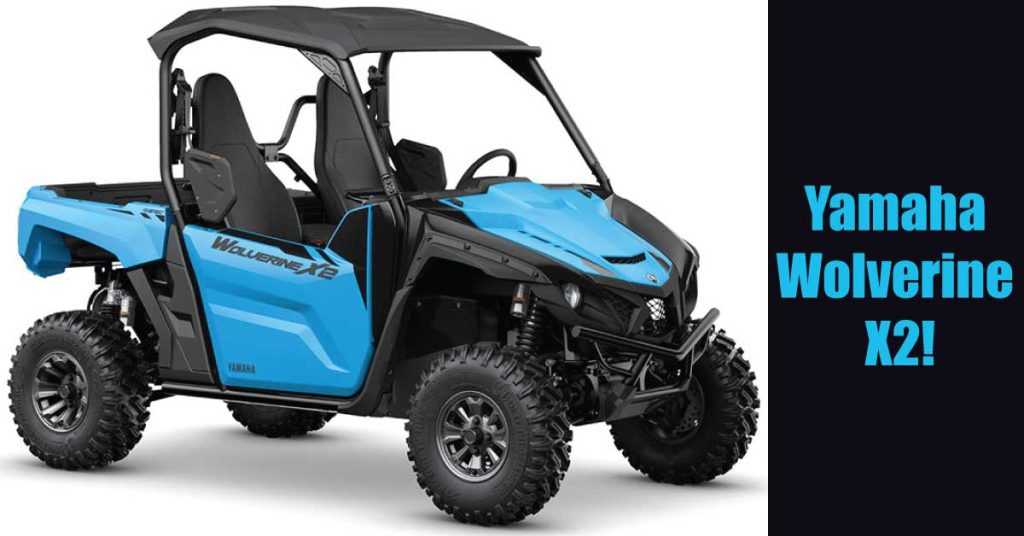
There are several distinct types of Yamaha Wolverine side-by-side. Even the same model type can vary from one edition to the next. However, some customers choose the larger 4-door Yamaha Wolverine X4, whereas others favor the agility and maneuverability of the compact 2-door Yamaha Wolverine X2.
The Yamaha Wolverine X2 Utility was developed with a rugged environment in mind. Thus incorporating Yamaha’s legendary Real World Tough endurance and dependability, the new X2 values work over recreation by offering a cargo compartment that is bigger than standard. Furthermore, a twin-cylinder 847 cc engine with Yamaha’s Real-World Technology, including the tried-and-true Ultramatic CVT gearbox, provides ultra-quiet, ultra-smooth propulsion.
But what really makes the Yamaha Wolverine X2 a good UTV? Let’s find out then.
Yamaha Wolverine X2 Specifications
The specifications for the Yamaha Wolverine X2 may differ based on the vehicle’s year and version. However, the following are some general specifications.
Chassis
- Frame Type: Steel tube
- Suspension Front and Rear: Independent double wishbone, 221mm wheel travel
- Brakes Front and Rear: Hydraulic dual discs
Engine
- Engine Type: Liquid-cooled, 4-stroke, DOHC, parallel twin
- Bore x Stroke (mm): 82.0 x 80.2
- Displacement (cc): 847.0
- Compression Ratio: 10.5:1
Performance
- Claimed maximum power and torque: 52hp & 81Nm
- Bed Capacity: 272 Kg (600 Lb)
- Towing Capacity: 907 Kg (2000 Lb)
Transmission
- Type: Yamaha ‘Ultramatic’ CVT auto
- Drive: Yamaha ‘On-Command’ 2WD/4WD/4WD plus diff lock
- Final drive: Shaft
Key Features of Yamaha Wolverine X2
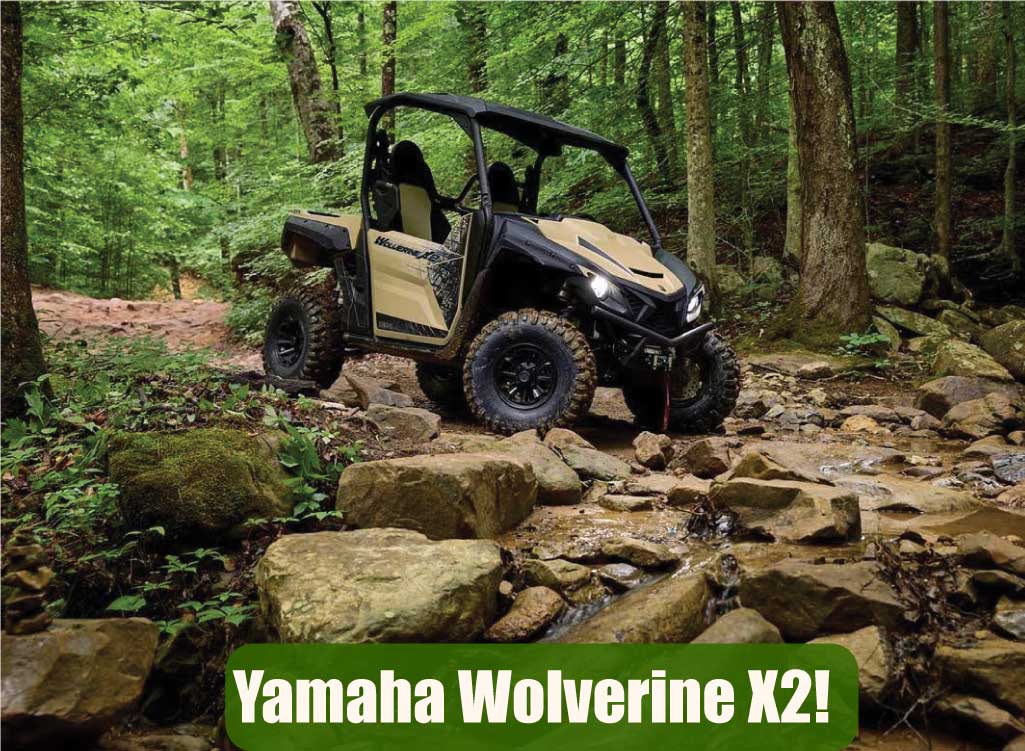
The Yamaha Wolverine X2 is equipped with a variety of features that enhance its off-road performance, comfort, and utility. Let’s take a look at some of its main features.
Powerful Twin Cylinder Engine
The 847cc parallel twin-cylinder engine uses all of Yamaha’s performance-enhancing technologies. Moreover, forged pistons and connecting rods ensure long-lasting performance at high rpm, and Yamaha’s 270° Crossplane Concept Crankshaft provides linear torque growth and great power at all rpm.
High-Performance Suspension
All four corners of the Wolverine X2 are equipped with a well-damped suspension for better chassis control and driving feel. These shocks give the X2 a versatile, well-balanced ride, so it can be used for hauling goods or going off-road.
Maximum Versatility
The Wolverine X2 has a big, tilting cargo bed. In addition, it is bigger than usual in width, length, and depth, and it is made to fit a box.
On-Command 4wd
With Yamaha’s well-known On-Command 4WD system, you can switch between 2WD, 4WD which has restricted slip, and 4WD with a completely closed differential. In contrast to automatic 4WD systems from competitors, On-Command gives the driver the ability to maximize the most possible traction on any surface.
Speed Management
The Wolverine X2 is also equipped with a Speed Control System that lets the driver set the vehicle’s top speed to 40 km/h. As a result it is great for construction sites and other places where the vehicle needs to function specially.
Quiet & Comfortable
The Wolverine X2 is one of the most comfortable and quiet side-by-sides that have ever been made. The refined twin-cylinder engine keeps vibration, harshness, and noise to a minimum. The Wolverine X2 850 is a remarkable recreational utility vehicle that perfectly balances both. Its interior is roomy and comfortable.
This is an excellent option if you spend long periods in the cabin. The high-back seats, padded knee areas, and adjustable driver seat and seatbelts rank highly in terms of comfort. Furthermore, the vehicle’s wide-open doors make entering and exiting a breeze.
Read More Yamaha Yfz450 Exhaust
Handling
The Wolverine X2 850 is a reliable ride with solid performance, although it may not offer any unexpected features. The KYB shocks may struggle with the vehicle’s weight, prompting some riders to desire an upgraded system akin to the Fox X2 850.
However, the 27-inch GBC Dirt Commander tires provide ample shock absorption for a smooth ride over rough terrain. Equipped with full underbody skid plates, riders can confidently navigate the vehicle without fear of causing damage.
Brake
The Yamaha Wolverine X2 850 boasts an exceptional braking system, with dual hydraulic disc brakes on both the front and rear. Its four-wheel engine braking system also ensures unparalleled performance on any terrain.
Towing
The X2 850 has commendable ergonomic features and performance capabilities. It falls within an intermediate range for payload and towing, with a bed that can hold up to 600 pounds and tilts for effortless maneuvering. Moreover, it can tow up to 2,000 pounds using a 2-inch hitch receiver. These ratings are satisfactory and appropriate for those seeking a balance between practicality and leisure.
Electronics
While not overly extravagant in technology, the Yamaha Wolverine X2 850 boasts various practical features, including electronic power steering, an LED dashboard display, and LED lighting. For those seeking even more advanced capabilities, the R-Spec and XT-R models come equipped to support the Yamaha Adventure Pro GPS.
Pros and Cons of Wolverine X2
The Yamaha Wolverine X2 is a dependable and adaptable UTV intended for rough terrain. These are some of this UTV’s primary advantages:
- Great Off-Road Capability
- Unique versatile design
- Comfortable Cabin space
- Powerful engine
- Vast Storage Capacity
Although the Wolverine X2 is a capable UTV, it’s not free from issues. Let’s have a look at some of its significant problems.
- Acceleration problem
- EPS Malfunction
- Glowing exhaust
- Header pipe cracks
- Stuck parking brake
- Flooded fuel tank
- Oil consumption problems
Yamaha Wolverine X2 Price: A Budget Friendly UTV
The initial price range for the base model of the Yamaha Wolverine X2 is approximately $12,000 to $15,000. However, it is essential to keep in mind that prices can fluctuate over time.
Our top choice is the R-Spec due to its stunning cyan paint job, even though the XT-R’s trim-specific paint is also impressive. By choosing the R-Spec, you can save an additional $1,600, which you can use to purchase the winch and rearview mirror that come with the XT-R.
Therefore, it is suggested that you confirm with Yamaha dealerships or online sources for the latest and most accurate pricing details.
Warranty and Maintenance
Those who purchase the 2023 Yamaha Wolverine X2 850 can expect to receive Yamaha’s standard six-month warranty.
Yamaha Wolverine X2 Accessories for Upgrade
The Yamaha Wolverine X2 is available with a variety of accessories that enhance its upgradability, ease, and security. Such as-
- Windshields: Full and partial windshields are available to protect riders from wind, detritus, and weather conditions.
- Roofs: Yamaha provides both hard and soft roofs for protection from the sun, weather, and branches.
- Bumpers and Brush Guards: Bumpers and brush guards may offer extra safety for the vehicle’s front and rear, protecting it from hits and debris.
- Skid Plates: During off-road excursions, skid plates safeguard the Wolverine X2’s chassis as well as essential sections from stones, branches, and other obstructions that could cause damage.
- Cargo Bed Accessories: Bed extenders, cargo boxes, cargo netting, and bed liners are available as accessories to increase the utility of the cargo bed.
Wolverine X2 Versions and Models
The Yamaha Wolverine X2 comes in a variety of models and variants, each of which offers a distinct set of benefits and designs. So here are some noteworthy Yamaha Wolverine X2 models and variants:
Yamaha Wolverine X2
This is the conventional Wolverine X2 model, which features a two-seat layout and a variety of useful and off-road features.
Yamaha X2 R Spec
The Wolverine X2 R-Spec model is intended for improved off-road capability. It typically consists of enhanced shocks, adjustable suspension settings, and other components that provide a more dynamic and effective ride.
Yamaha Wolverine X2 850 SE
The Special Edition (SE) model of the Wolverine X2 provides enhanced styling and convenience benefits over the standard model.
Final Thought: A Unique UTV to Choose!
If you are a Trail rider or an off-road enthusiast who desires a robust suspension, a powerful engine, and capable off-road performance. Then, a top-notch Yamaha Wolverine X2 for sale may be what you’re looking for these days.
Although the Wolverine X2 has farm-friendly advantages, its engine, chassis, suspension, and handling characteristics make it a highly potent vehicle on bush trails.
To figure out if the Yamaha X2 is the best option, you have to analyze your needs, consider the intended application of the vehicle, and assess aspects such as budget, preferred features, and local regulations.
FAQs
What engine does the Yamaha Wolverine possess?
The Yamaha Wolverine X2 is equipped with a liquid-cooled 847cc inline twin-cylinder engine. It is fuel-injected and engineered for both efficiency and torque.
What is the number of seats in the Wolverine X2?
The Yamaha Wolverine X2 is equipped with two chairs for a driver and a passenger. Off-road, the seats are designed for comfort and provide substantial support.
How much cargo space does the Wolverine X2 have?
The cargo compartment of the Yamaha Wolverine X2 can accommodate up to 600 pounds. It enables you to carry a variety of items, such as tools, equipment, and supplies, making it useful for both work and play.
Is the Wolverine X2 equipped with four-wheel drive?
Yes, the Yamaha Wolverine X2 has an on-demand four-wheel drive system. Depending on the terrain and driving conditions, it may switch between 2WD and 4WD modes. Furthermore, a differential lock enhances traction in difficult conditions.
Is the Yamaha X2 compatible with any optional accessories?
Yes, Yamaha offers a variety of optional accessories for the Wolverine X2, allowing you to personalise your vehicle to your specifications. Windscreens, roofs, winches, LED lighting packages, cargo boxes, and audio systems are typical accessories.
RELATED:
Yamaha 80 Dirt Bike, Specs, Features & More!












About